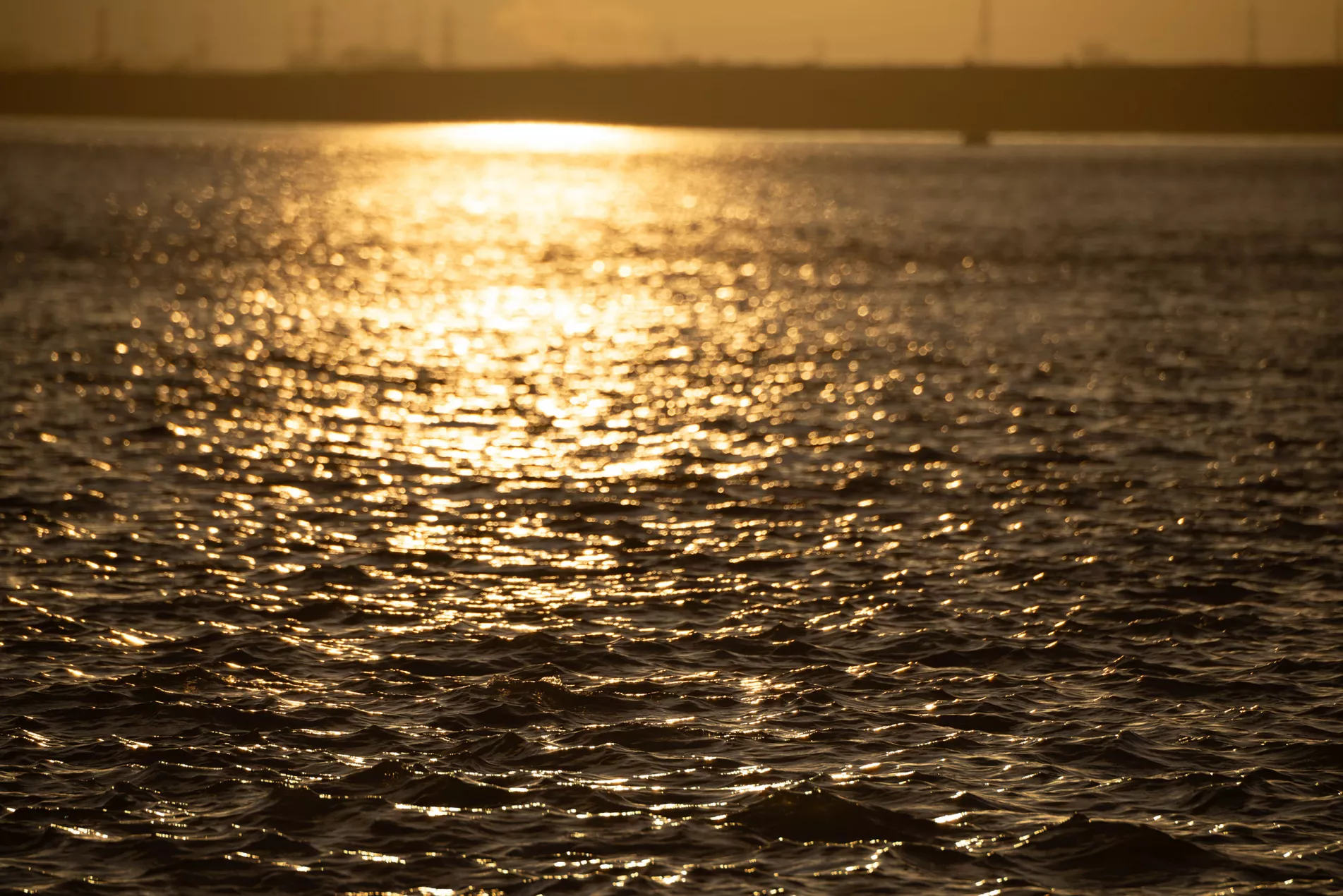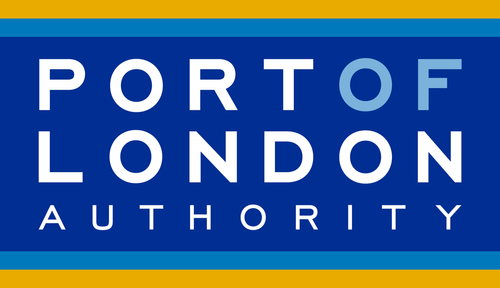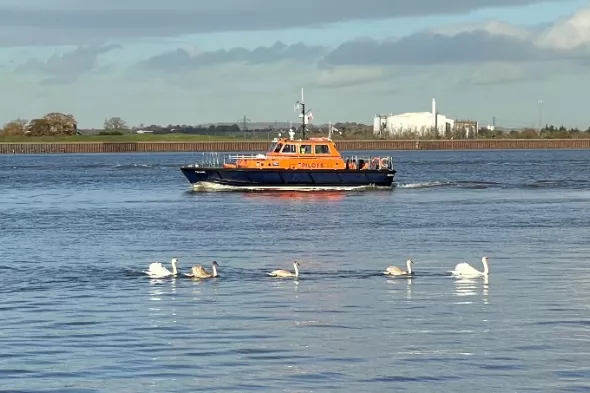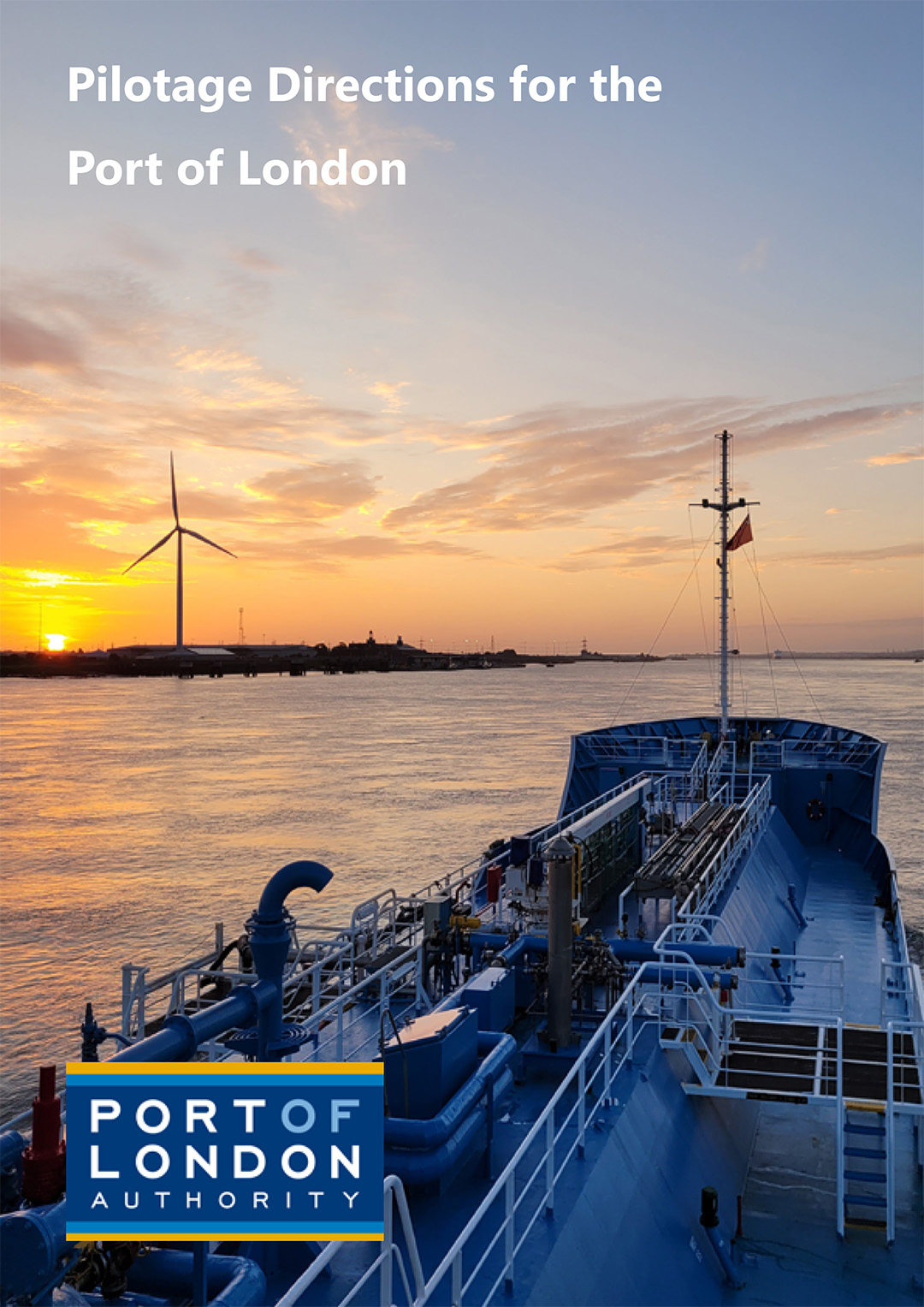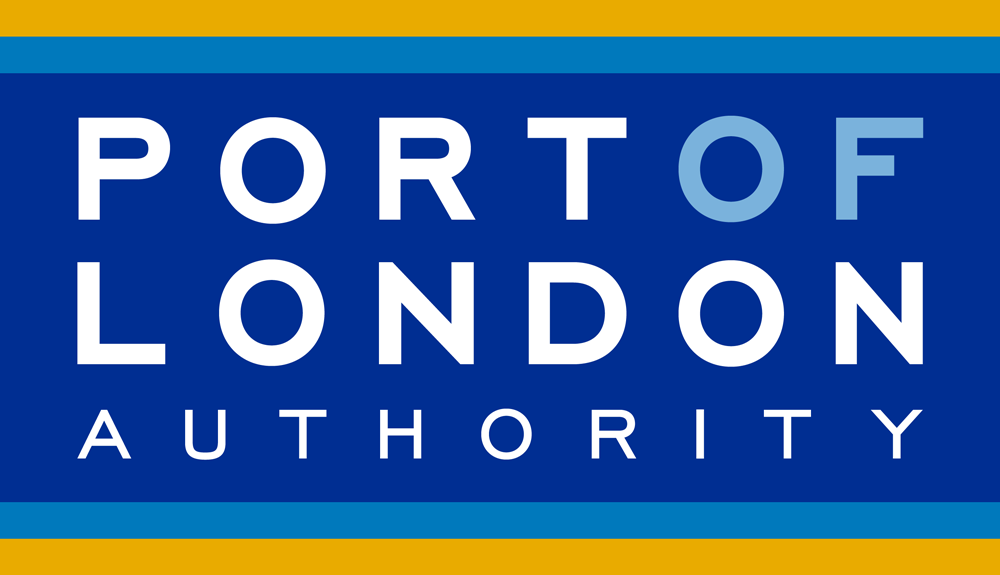Live Tides
NOTICES TO MARINERS
Charts & Surveys
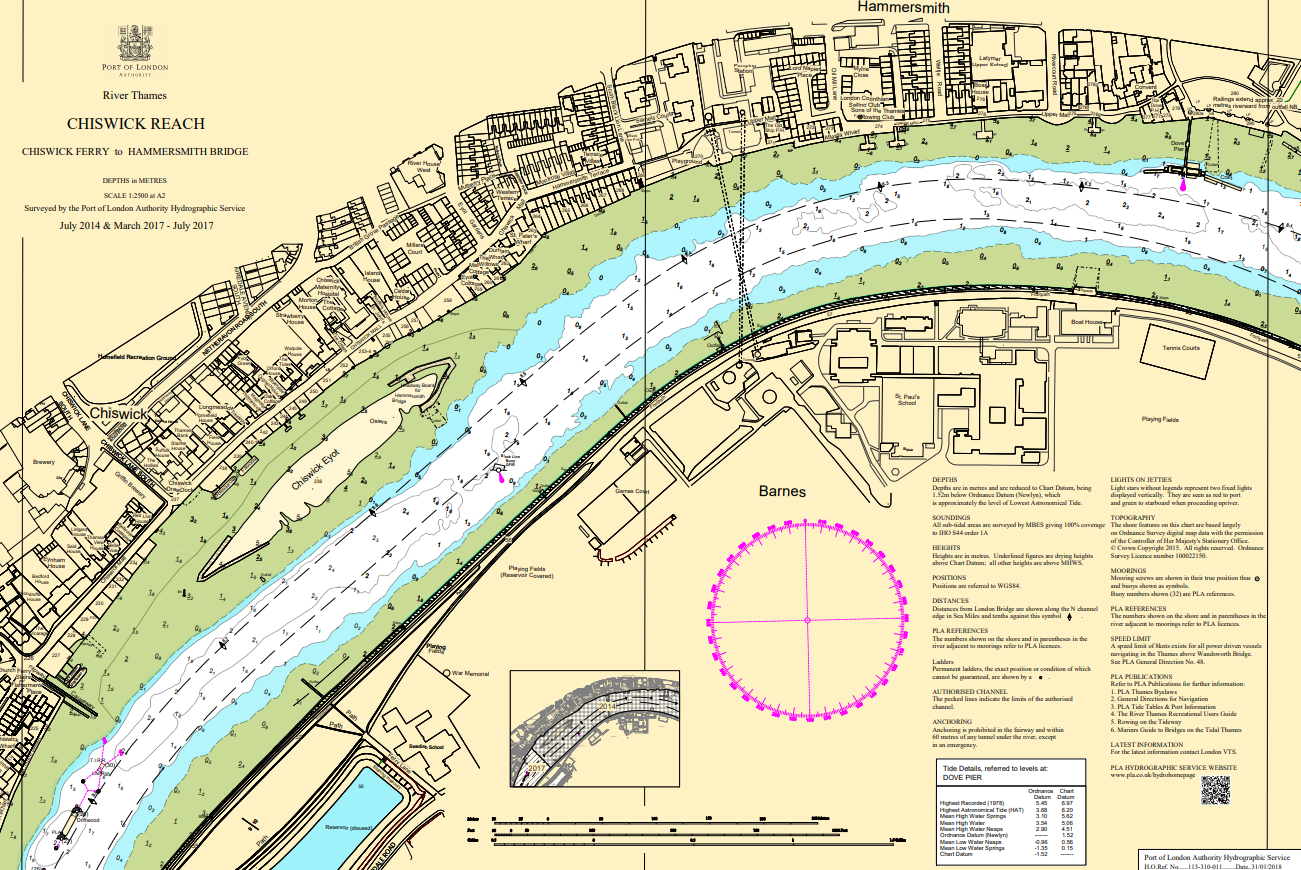
Incident reporting
Life-threatening emergencies on the river:
Call 999 and ask for the Coastguard
For near miss, safety observations and incident reporting click below
Assessing asset integrity
We can help you assess your assets.
We can acquire a bathymetric survey with a multi-beam echo sounder and combine this with an above water survey for you.
The result will be a seamless data set. We acquire the above water survey on a low tide and the below water survey on the high tide. This results in an overlap in the two data sets.
For the above water survey, we can acquire vessel-based laser, land-based laser, or aerial drone photogrammetry.
Benefits:
- All survey data in one place
- Easy to extract measurements
- Assurance that the two data sets align
Deliverables:
Interactive 3D point cloud model hosted the web.
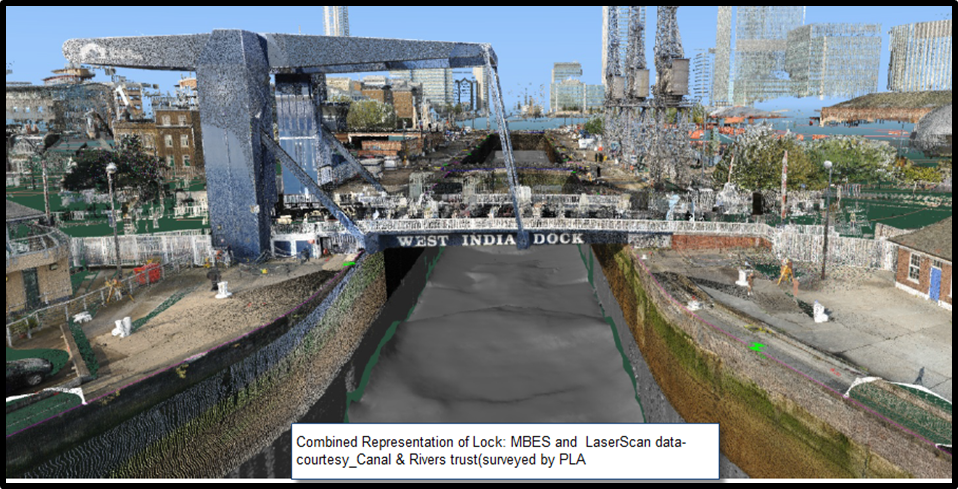
Using a multibeam echo sounder, the PLA can conduct a survey of a river wall for you. For this we usually tilt the multibeam so it is directed to the wall.
The point cloud data produced will allow defects -- such as missing bricks in the wall shown at right -- to be easily identified. This method is safer and more efficient than putting divers in the water.
It then allows any diving, if required, to be focused on areas of concern.
Benefits:
- Easy to take measurements from the data
- Can identify defects
- Historic record in case of any future damage
- Can reduce diver time and focus attention to defects
Deliverables:
- Interactive 3D point cloud model hosted the web
- Report

The PLA can gather bathymetric data over the scour protection, this will show if there is any erosion of material an allow early intervention.
This could be scour protection placed over the top of a tunnel, so it is important to know there is adequate coverage above the tunnel.
Additionally, if the surveys are repeated, you will be able to see the changes over time.
Benefits:
- Reduce risk
- Allow intervention before it’s too late
- Historic record
Deliverables:
- Interactive 3D point cloud model hosted the web
- Report

The PLA can capture a multibeam echo sounder image of the structure for you, which allows you to view the asset as 3 dimensional model.
For this the PLA vessel would move around the structure with the multibeam echo sounder tilted to look at the structure, so allowing maximum imaging of the asset.
In addition, the PLA can deploy divers to take ultrasonic thickness measurements, if required, thus building up a more complete picture of the asset.
Benefits:
- Easy to take measurements from the data
- Can identify defects
- Historic record in case of any future damage
- Can reduce diver time and focus attention to defects
Deliverables:
- Interactive 3D point cloud model hosted the web
- Plots
- Survey report(s)

The PLA can produce high resolution georeferenced photography. This will allow easy management of a large number of photographs.
Benefits:
- Georeferenced so that the photos can be displayed in Google Earth or similar viewer for easy management
- High resolution so that the images can be zoomed to see details
Deliverables:
- Report
- Georeferenced Images
- KML file for viewing in google earth

The PLA can acquire multibeam echo sounder over the pipeline route and identify any exposed sections. This will allow early intervention before pipe failure.
Also if you wanted to purchase a pipeline assets, such a survey would help confirm its condition ahead of purchase.
Benefits:
- Safe and non-intrusive.
- Calculation of fill volumes required can be generated
- Cost saving by early intervention
Deliverables:
- Interactive 3D point cloud model hosted the web.
- Plots
- Survey report

The PLA can collect data from a vessel mounted laser linked to the vessel's positioning system, allowing it to capture data as the vessel moves.
An ideal solution for survey of bridges, piers, and jetties. An example is shown in the grey scale image at right.
Benefits:
- Data importable into CAD packages
- Data can be integrated with multibeam echo sounder data to generate a seamless data set.
- Can take measurements from the data set
- Can generate profiles and cross sections
Deliverables:
- Report
- Point cloud
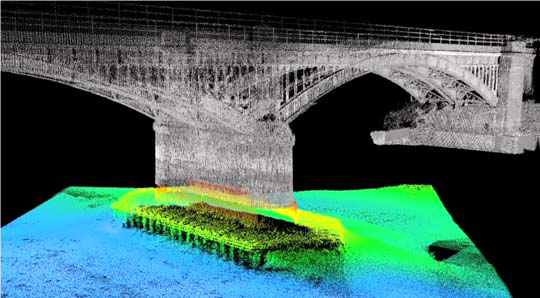
Support for dredging
The PLA can assist and advise on your dredging project throughout its lifecycle
Need to acquire and test samples pre dredging work?
We can acquire surface samples using hand grabs and day grabs from a vessel, or collect from the foreshore.
Benefits:
- Knowledge of the requirements
- Fast turnaround
- Options for additional testing
Deliverables:
- Sampling report including:
- Charted samples locations
- Chain of custody
- Description of sample method
Need to know volume of material to dredge and confirm dredging performed as planned?
The PLA can acquire bathymetric surveys pre and post dredging operations.
Benefits:
- Easy to take measurements from the data
- Can identify defects
- Historic record in case of any future damage
- Can reduce diver time and focus attention to defects
Deliverables:
- full xyz point cloud
- decimated xyz point cloud
- Fledermaus scene file
- Plots
- Survey report(s) specifying including:
- Controlling depths on the berths.
- Outline of operations
- The extent of any obstructions, scour or other notable features
- Volume calculations, difference surfaces and associated specified deliverables will be included in the reported Post-Dredge survey.
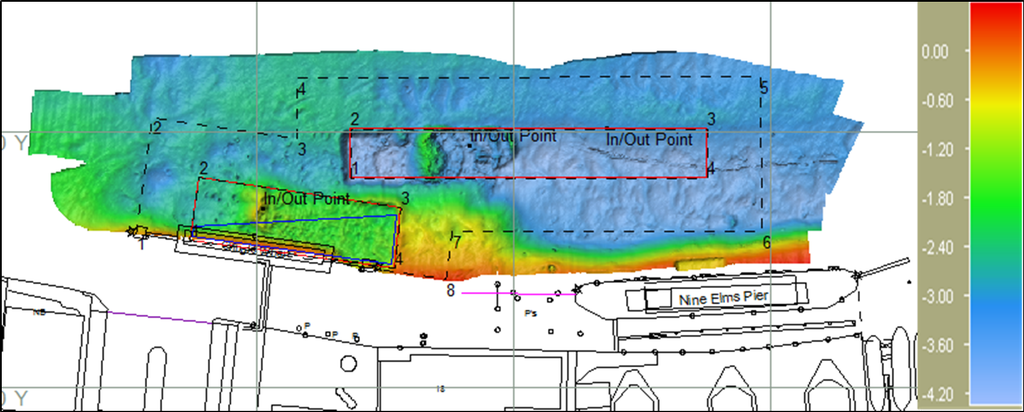
Need to see changes over time?
The PLA can acquire surveys over the same areas at different times and generate difference models between these to show the changes over time.
Benefits:
Know about any scouring or accretion as soon as possible so action can be taken.
Deliverables:
- Full xyz point cloud
- Decimated xyz point cloud
- Fledermaus scene file
- Plots
- Survey report(s)

Need to know volume of material to dredge to be dredged, or and confirm how much was material has been removed?
The PLA can use the bathymetric data to calculate the volumes you need to know, either planned dredge volumes, or post dredge.
Example of volumes for volumes for different target depth:
Benefits:
- Facilitates dredging license applications
- Can weigh the costs/benefits for different dredge depths
- Offers an independent volume calculation, where contractors are on a per m3 rate
Deliverables:
- Survey report with required volumes
- Chart showing the planned dredge area
Survey of depths on berth
Need to know what depths you have on your berth?
We can acquire a bathymetric survey and chart this for you.
Benefits:
- Reduce the risk of vessel grounding
- Can be used to guide for when dredging is required to maintain depths
- Know what draft of berth you can safely accept
- Know about any obstruction
Deliverables:
- xyz point cloud
- Web based 3D visualisation of the point cloud data
- Plots
- Survey report(s) specifying including:
- Controlling depths on the berths.
- Outline of operations
- The extent of any obstructions, scour or other notable features
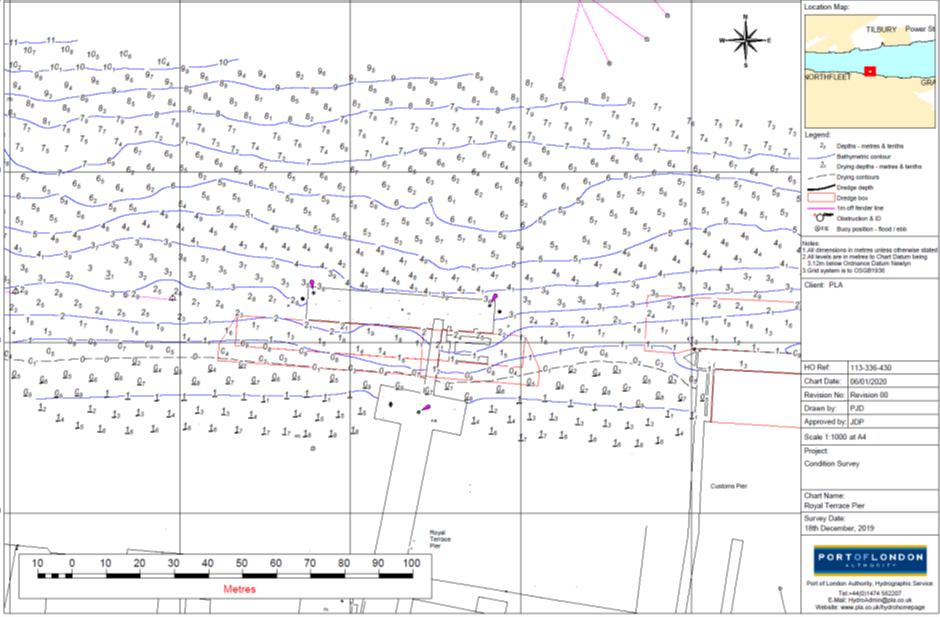
Port of London Authority welcomes four more Pilots to meet increasing demand
Four Pilots have joined the Port of London Authority (PLA)’s 123-strong team of Pilots, as the demand for pilotage services in the UK’s busiest port continues to grow.
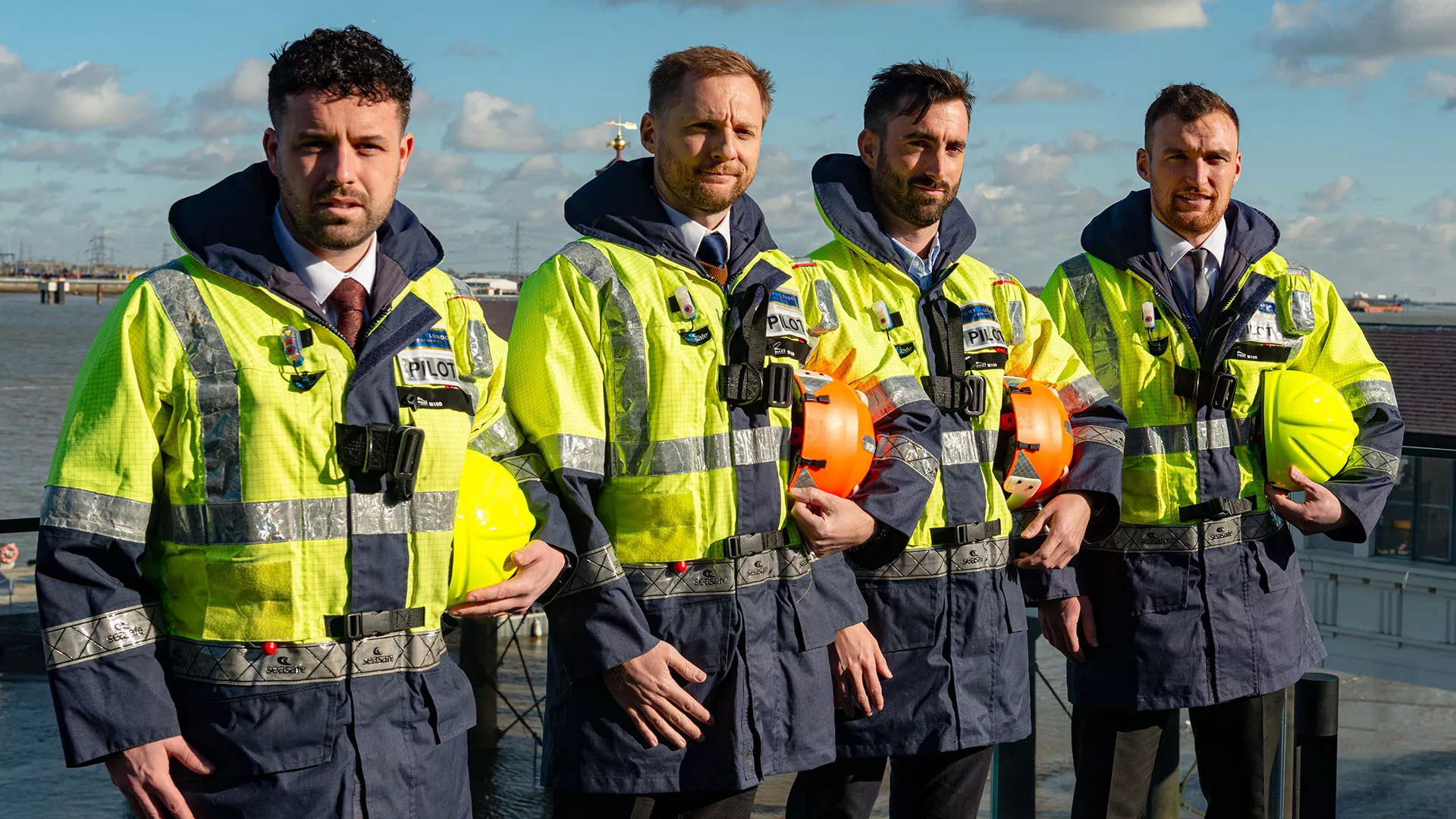
- Significant growth of trade is expected on the river
- Supporting our Thames Vision goal of continuing investment in pilotage
With the new fourth berth at London Gateway expected to be completed in early summer this year, significant growth of trade is expected on the river increasing demand on our vital service.
In 2023, the PLA achieved a 99.6 per cent pilotage service level for customers, during which our pilots guided 13,707 vessels along the river and estuary.
Embarking on a comprehensive training programme, which will equip them for the unique challenges of navigating the Thames, are:
- Patrick Kelly started his seagoing career as a Trinity House Cadet, before joining Princess Cruises as Third Officer, progressing to Second Officer. Patrick joined Stena Line in 2020 as Chief Officer and was subsequently promoted to Captain.
- Daniel Tolley began as a Cadet at Warsash Maritime Academy and has worked on Maersk container ships throughout his career. Eventually Daniel progressed to Chief Officer on the largest ships in the Maersk fleet.
- James Terry started at Thomson Cruises as a Cadet and, aside from year gaining experience in towage with Svitzer, James has spent his whole career at Thomson/Marella Cruises, working his way up to Staff Captain.
- Declan Farren, who studied at Fleetwood Nautical College, began his career at sea with Princess Cruises. He then moved to Virgin Voyages, working his way up to Safety Officer.
Dave Newbury, the PLA’s Marine Pilotage Manager said:
“Marine Pilots board vessels in all weathers 24/7, 365 days a year, with vessels carrying everything from food, fuel and vehicles, to building materials and aggregate. Guiding these ships to and from their berths within the river Thames demands a high level of specialised training, skill and navigational awareness.
“Expanding our pool of available talent means we will be able to remain resilient and will also help increase the volume of freight delivered to this country via the river Thames.”
Related content

Location: London/Gravesend Remuneration: £28,971 per annum for a commitment of up to 24 days per...
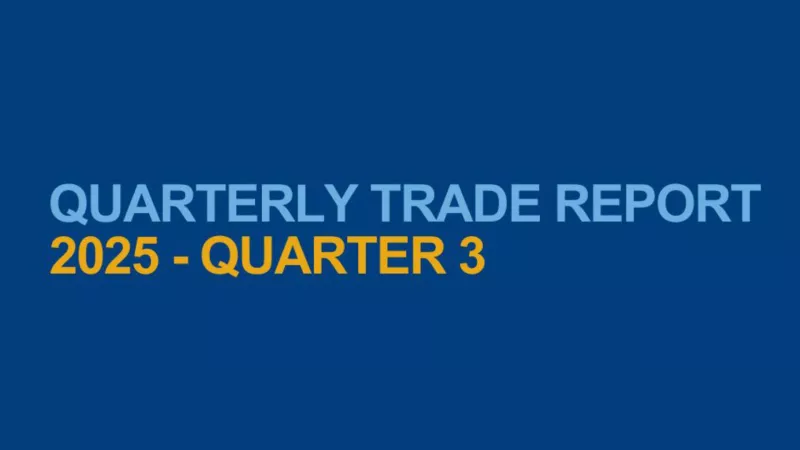
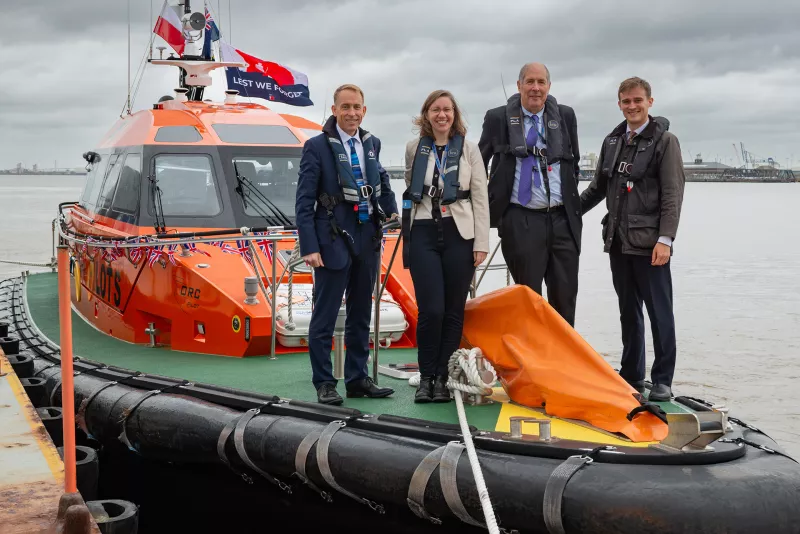
UK’s largest port awards contract for cutting edge VTS system
The Port of London Authority is pleased to announce that, following a thorough tendering process, it has signed a contract with Kongsberg Norcontrol Ltd to replace its Vessel Traffic Services equipment.
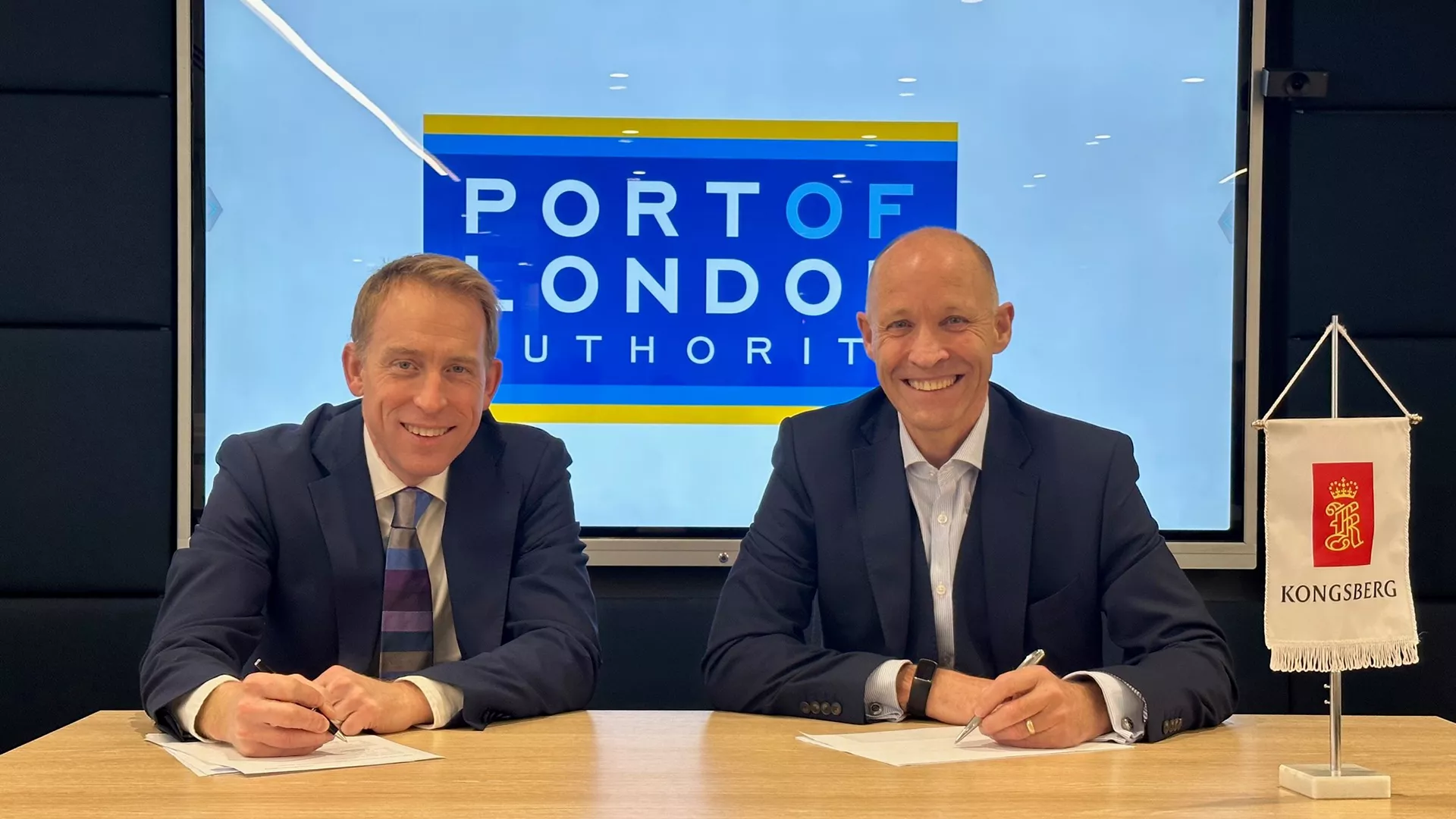
- Contract will deliver a future-proofed Port Control Centre
- Kongsberg Norcontrol Ltd is the UK arm of Kongsberg Norcontrol AS
This is a key part of its Thames Vision 2050’s Marine Centre Transformation Programme which will deliver a future-proofed Port Control Centre, with the right technology and resilience to support the next quarter century of growth at the UK's largest port.
The PLA’s Vessel Traffic Services are essential to providing operators with information and responding to developing traffic situations along the tidal Thames, to improve the safety and efficiency of navigation, as well as to protect the marine environment.
PLA’s Director of Marine Operations, Steven Clapperton, said:
“This is a multi-million-pound scheme and will provide London VTS with state-of-the-art equipment, enhancing and improving our operational performance. All delivered into a brand new operations centre ready to accommodate the expected growth of trade on the river, which is set to rise from 55 million tonnes per year to 78 million tonnes by 2050.”
PLA’s Head of IT, Anthony Fletcher, added:
“The technology within the Kongsberg system is tried and tested whilst remaining at the forefront of industry capabilities. KNC is a global market leader and the long-term partnership and support arrangements that will follow this installation put us in good stead for many years to come.”
KNC Ltd’s Sales Manager, Mike Sheard, said:
“It has been a pleasure getting to know the PLA and especially their Vision for the Thames in 2050. This PLA vision aligns with our funded Research & Development roadmap in terms of helping our customers and protecting the environment. I’m particularly excited because the contract includes an extensive Managed service support package ensuring the PLA will benefit from our forthcoming innovations including autonomy.”
The PLA’s Marine Centre Transformation Programme is a multi-million pound and multi-disciplined scheme to transform London VTS operations. The scheme is due to complete in 2026.
Related content

Location: London/Gravesend Remuneration: £28,971 per annum for a commitment of up to 24 days per...



Foreword from the Chief Executive
 It is my privilege to introduce our Marine Safety Plan (2024-2026), which outlines our commitment to ensuring continued safety of all those who navigate within our port and its surrounding waters.
It is my privilege to introduce our Marine Safety Plan (2024-2026), which outlines our commitment to ensuring continued safety of all those who navigate within our port and its surrounding waters.
Over the past years, we have worked tirelessly to maintain a safe and secure port environment. However, we recognise that there is always more work to be done, and we must continuously strive to improve our safety measures and practices.
Our new Marine Safety Plan represents a progressive approach to navigational safety, encompassing both traditional and innovative methods to address the dynamic challenges that we face in the maritime industry. The plan covers a range of initiatives that address the diverse risks associated with marine operations, including the implementation of advanced technology, the improvement of operational procedures, and the promotion of a culture of safety amongst all stakeholders. We are also committed to collaborating with our partners to deliver enhanced safety outcomes and to ensuring our employees are suitably trained and qualified.
I would like to express my sincere gratitude to all of our stakeholders, employees, and partners for their continued commitment to navigational safety. I am confident that our Marine Safety Plan 2024-2026 will position us well to maintain and enhance our reputation as a world-class port, where maritime safety and efficiency are at the forefront of all our operations.
Robin Mortimer, Chief Executive
Forward from the Chief Harbour Master
 The Port of London is a vital gateway for commerce and trade, and we understand the national importance of maintaining a safe and efficient waterway for all users. With this plan, we aim to enhance our existing navigational safety measures and will continue to adapt to new and emerging risks in the maritime industry.
The Port of London is a vital gateway for commerce and trade, and we understand the national importance of maintaining a safe and efficient waterway for all users. With this plan, we aim to enhance our existing navigational safety measures and will continue to adapt to new and emerging risks in the maritime industry.
Over the next three years, we will prioritise investment in technology, infrastructure, and personnel to improve our ability to respond to emergency situations and prevent incidents from occurring. We will also continue to work closely with our stakeholders, including shipping companies, tug and barge operators, and recreational users, to promote a culture of safety and responsibility on the tidal Thames.
Navigational safety is a shared responsibility and we welcome your feedback and collaboration as we work together to ensure the safe and efficient operation of our port. I look forward to working with all of you to achieve our shared goal of a safer and more secure maritime environment.
As part of our ongoing efforts to improve safety in the port, planning for the Marine Centre Transformation Programme is well under way. This project will include the construction of a new state-of-the-art London Port Operations Centre, equipped with the latest technology and software to enhance our real-time planning and monitoring of vessels navigating on the Thames.
The design of the new building will provide a centralised location for emergency response coordination, equipped with cutting-edge technology and facilities. This centre will also serve as a hub for training and exercises to improve our readiness and response capabilities.
The Marine Centre Transformation Programme is an investment in the safety and security of our port, and we are confident that it will enhance our ability to provide world-class services to all our stakeholders.
Thank you for your continued support, and we look forward to sharing more details about the Marine Centre Transformation Programme in the coming months.
Marine Centre transformation programme
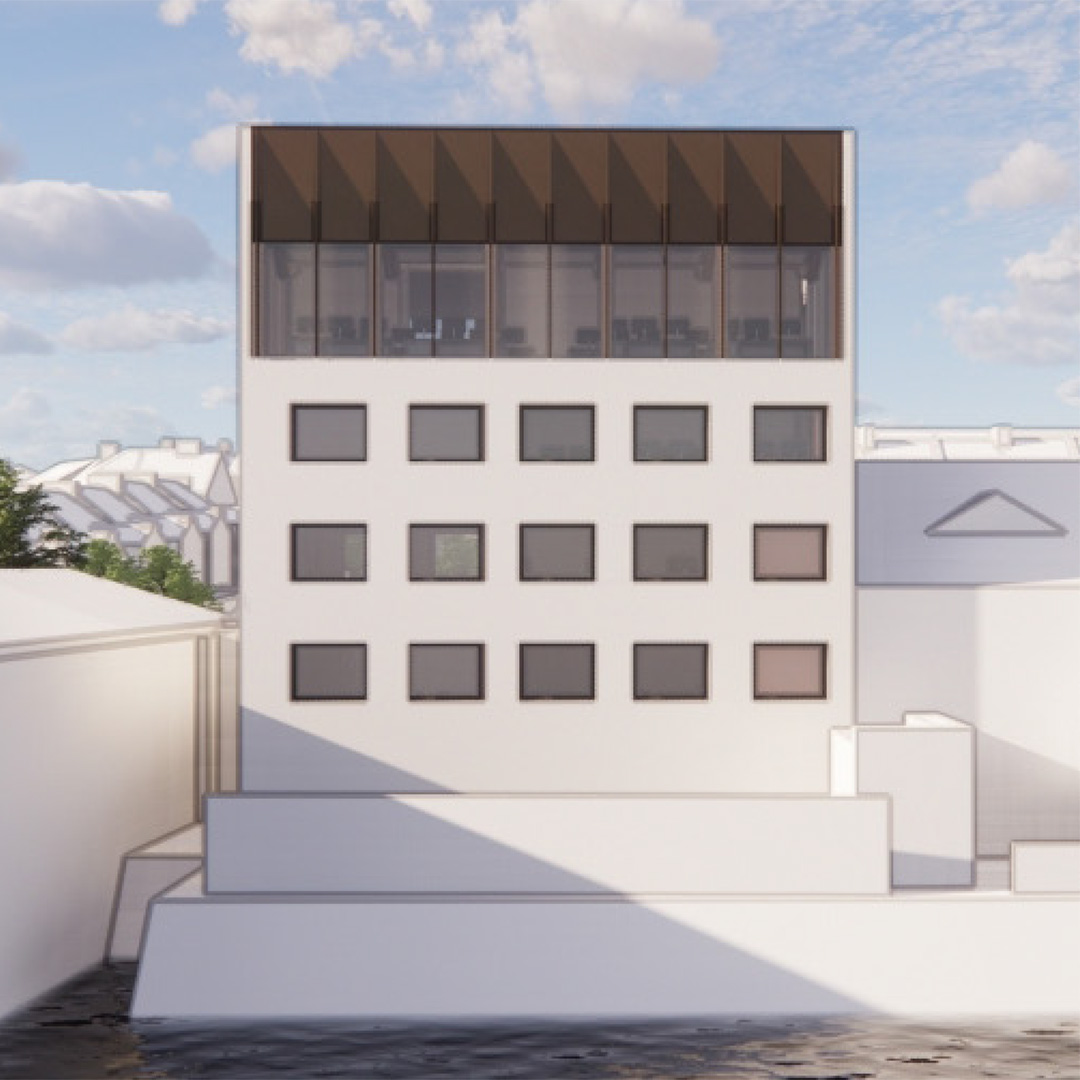 We are pleased plans for the development of a new, state-of-the-art, London Port Operations Centre at Gravesend are now well underway. The largest single investment in the PLA’s core safety of navigation activities in more than two decades, at £10 million, this is a key part of our plans for growth, captured in Thames Vision 2050.
We are pleased plans for the development of a new, state-of-the-art, London Port Operations Centre at Gravesend are now well underway. The largest single investment in the PLA’s core safety of navigation activities in more than two decades, at £10 million, this is a key part of our plans for growth, captured in Thames Vision 2050.
The new centre is key to our future as a thriving hub for trade, handling the port trade cited in the vision, of up to 80 million tonnes of cargo a year by 2050.
Equipped with the latest technology, the new centre will:
- provide a seamless service along the river, from one place;
- deliver an improved, and ergonomically designed workspace;
- integrate with the expected evolution of systems onboard vessels; and
- handle the comprehensive planning needs of the greater number of larger ships calling on the Thames.
This is an exciting phase in our continued development and a major investment by the PLA in the long-term future of the UK’s leading trading hub. It will equip us for the future of a busy, growing and complex port.
To maintain a resilient service for our customers, the project will be completed in phases:
- Phase One – Alexandra House refurbished as needed, port control systems specified and ordered.
- Phase Two – systems set up in Alexandra House; all port control operations transfer there, both Gravesend- and Thames Barrier-based. Expected: early 2025
- Phase Three – Gravesend port control building refurbished. Expected completion: early 2026
- Phase Four - new systems transfer to new Centre and it becomes fully operational.
Introduction
Port Marine Safety Code & the Maritime Safety Plan
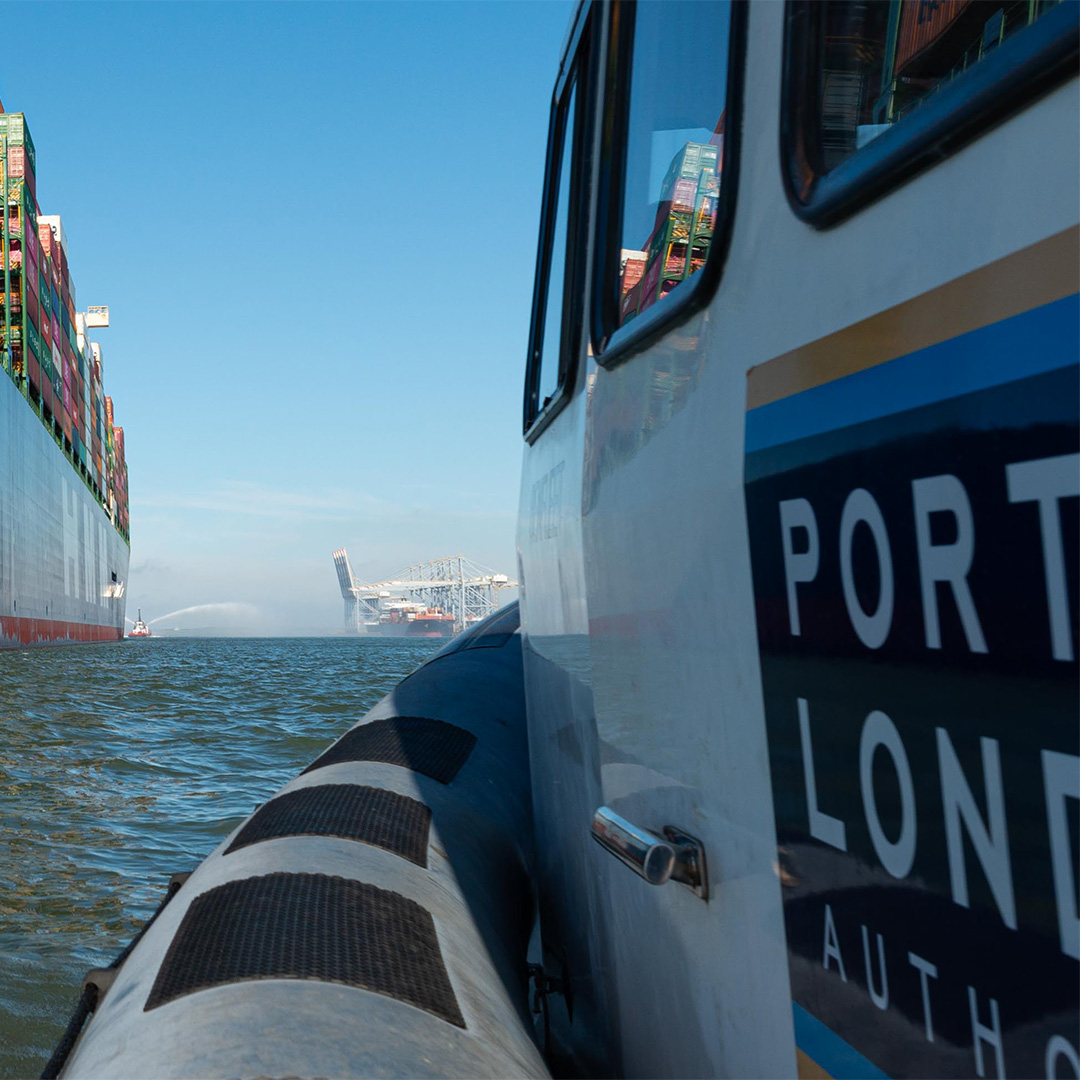 As required by the Port Marine Safety Code (PMSC), the Port of London Authority (PLA) publishes its Marine Safety Plan for the conduct of marine operations in the Port of London every three years; this plan covers the period January 2024 to December 2026.
As required by the Port Marine Safety Code (PMSC), the Port of London Authority (PLA) publishes its Marine Safety Plan for the conduct of marine operations in the Port of London every three years; this plan covers the period January 2024 to December 2026.
This Marine Safety Plan commits the PLA to undertaking the proper management and regulation of marine navigation within the scope of its powers and authority, according to Port of London Act 1968 (as amended) and the PMSC.
The PLA has a responsibility for maintaining the safety of navigation for all river users on the tidal Thames, together with a duty to improve and conserve the river and its environment. In managing the safety of navigation and the provision of services, the PLA always has the safety of life, vessels and the environment as its highest priorities.
What is the Port Marine Safety Code?
The ‘Port Marine Safety Code’ sets out a national standard for every aspect of port marine safety. Its aim is to enhance safety for everyone who uses or works in the port marine environment.
It is endorsed by the UK Government, the devolved administrations and representatives from across the maritime sector and, while the Code is not mandatory, these bodies have a strong expectation that all harbour authorities will comply.
It applies to all harbour authorities and other marine facilities, berths and terminals, in the UK and is intended to be flexible enough that any size or type of harbour or marine facility will be able to apply its principles in a way that is appropriate and proportionate.
Navigational Safety Policy
The PLA has a Navigational Safety Policy which outlines its compliance with the standards laid down in the Port Marine Safety Code (PMSC) and the management of navigation shall be in accordance with those standards.
The Navigational Safety Policy covers:
- Safety Management Systems
- Vessel Traffic Service
- Pilotage
- Hydrography
- Vessel Licensing
- Management of River Activities and Works
- Emergency Preparedness and Response
- Enforcement and Prosecution
- Marine Training
- Consultation
- Environment
The PLA also has an Environmental Policy and other non-marine policies such as the Drug and Alcohol, Health and Safety, and Security Policies which are applicable to marine staff within the PLA.
Safety Management System
A comprehensive overview of the structure, management and maintenance of the port’s Marine SMS and the PLA’s compliance with the PMSC in support of this Plan, is contained in the Marine SMS Manual. External audits of the PLA’s compliance with the PMSC are undertaken at least every 3 years, through an annual rolling programme, supplemented by regular internal audits and health checks.
Developing the plan
This Marine Safety Plan for 2024-2026 has been developed with the goal of enhancing safety. To achieve this, the team responsible for the plan conducted extensive consultations with Port of London Authority (PLA) employees to identify areas that require improvement and develop strategies to address them.
The first step in developing the Marine Safety Plan was to gather data on current safety practices and analyse areas where safety could be enhanced. This was done through a thorough review of safety policies and procedures, as well as consultations with stakeholders in the marine industry, including the PLA employees who have direct experience with safety issues.
The next step involved working with PLA collegues to identify specific safety challenges and opportunities for improvement. This included looking at the latest trends in marine safety and identifying areas where safety risks are increasing, such as the use of new technologies or changes in environmental conditions.
Based on this information, we developed a comprehensive Marine Safety Plan that includes a range of initiatives and strategies to enhance safety across the entire marine environment. The plan addresses both operational and strategic issues, including communication, training, equipment, and emergency response.
To ensure the success of the Marine Safety Plan, we are committed to working closely with colleagues, fellow river users and other stakeholders throughout the implementation process. This includes ongoing communication, regular updates, and consultations with all parties involved.
Overall, the development of this Marine Safety Plan is a critical step towards enhancing safe navigation in the marine environment.
Marine Safety Plan
2024-2026
 Safety Management Systems
Safety Management Systems
- Over the course of the plan review all General and Pilotage Directions, Byelaws, Navigational Risk Assessments and SMS Documents. This review should refine content for ease of use and understanding - ensuring conciseness where possible - whilst continuing compliance with the Port Marine Safety Code (PMSC).
- Produce annual safety campaigns. Each campaign will aim to promote a culture of safety amongst river users and be assessed on its effectiveness through internal reporting. One campaign shall specifically target the promotion and embedding of the Thames CPD scheme role out.
- Develop a multi-faceted, comprehensive wash-on/draw-off strategy to increase awareness of the associated hazards and best practice techniques, resulting in an overall improvement in safety culture amongst all relevant river users.
- Any non-compliance identified through audit, to be closed within agreed time scales.
- Following on from the success of the PLA’s Safe Boarding Week (launched in 2023), the PLA commits to running the campaign annually during the period of the plan. In addition, the PLA will work with operators, terminals and other organisations such as the UKMPA to continually improve the safety of vessel boarding arrangements.
Pilotage
- Maintain a year-on-year average Pilot Service level of above 98% by providing a pilotage service of well-trained, suitably qualified and authorised pilots that is supported by appropriate recruitment.
- Deliver a full simulator training programme for PLA Pilots to ensure PLA Pilot skills and knowledge remain current and appropriate to Class.
Pilotage Exemption Certificates (PECs)
- Process all PEC applications for new certificates and renewals with 2 working days of completed paperwork being submitted, in order to avoid delays or additional costs to operators due to PLA administration of the PEC system.
Vessel Traffic Services (VTS)
- Maintain an effective VTS across all sectors in accordance with UK national, IMO and IALA standards ensuring a 99.9% service availability for the life of the plan.
- Ensure no VTS assisted navigational incidents take place.
- Establish and commission a new, single location Port Control Centre to:
- Provide a seamless service along the river.
- Integrate with the expected evolution of systems onboard vessels.
- Handle the comprehensive planning needs of the increasing number of larger ships calling on the Thames.
Vessel Licensing
- Complete 90% of all license applications within 10 working days of receipt.
- Conduct a full review of the Human Powered Vessel licence scheme with an objective to simplify the process for the benefit of the stakeholder.
Vessel Survey
- Achieve 100% follow up rate on withheld certificates.
- Visit 100% of vessels who request a survey within 6 weeks.
Hydrography
- Publish annually, and deliver, a SMART safety of navigation programme achieving a minimum 95% of target km.
- 56 Tidal Station Calibration visits (four per Gauge per quarter).
- Two x Tidal Stream Surveys per year.
- Extend official ENC (electronic navigational chart) coverage to our up-river limits east of Teddington.
- Complete the move to ENC First, providing digital chart products covering both the river and estuary, and accessible to all mariners (both leisure and commercial).
- Identify, trial and implement technology to improve hydrographic performance (time taken from “Ping to Product“) by 10% over the period of the plan.
Management of River Works & Activities
- 100% of works licence requests to be responded to within respective time frames.
- Maintain a regular liaison schedule with Tideway representatives, ensuring that marine activities supporting conclusion of the Thames Tideway Tunnel project are managed effectively and adequately risk assessed using site specific risk assessments, and a project wide cumulative navigation risk assessment; the latter reviewed monthly.
Emergency Preparedness & Response
- Run at least two incident management exercises per year dedicated to the training and development of marine staff.
- Attend at least two exercises per year with external stakeholders such as local authorities and/or the emergency services.
- Conduct at least one Oil Spill Exercise, which includes the activation of the Marine Emergency Centre, during the period.
- Before the end of the period of the plan, establish and commission a brand-new ‘Marine Emergency Centre’ to facilitate the PLA’s ‘Category 2’ responder status under the Civil Contingencies Act 2004.
Enforcement & Prosecution
Recent and upcoming additions to the PLA’s General Directions will require initial monitoring and assessment to ensure the port fulfils its statutory duties. To that end, the PLA commits to;
- Monitor compliance of General Direction 32 (Vessel Registration Requirements) and 34 (Continuous Professional Development) through:
- Harbour Service Launch spot checks – conduct at least eight per month for Middle HSL , and eight per month for Upper & Lower HSLs.
- Conduct at least one office based electronic check per month.
- Monitor compliance of General Direction 10.1 (Discharge of Sewage) through a schedule of a minimum of ten vessel/organisational audits per year.
- Ensure all bathymetric surveys at operational berths have been submitted to the Authority as per the requirements of Byelaw 51. Where such surveys have not been submitted as required, appropriate action is taken by the Authority to best ensure compliance.
Plan performance
Performance against the objectives set within the Marine Safety Plan 2024 will be continually monitored, evaluated and reported on throughout the period. Performance will be internally monitored on a monthly basis, by the Marine Management Team, who may set additional actions if performance falls below expectations.
The Authority’s Marine Compliance Department will produce and publish bi-annual and annual performance reports each calendar year. Upon conclusion of the period, a final report will be published to evaluate performance against each objective set in the plan. Bi-annual, annual and final reports will be made available to the public on the Authority’s website (www.pla.co.uk).
Annual Performance Report 2024
Marine Safety Plan 2021-2023
The document reports on the targets and objectives as laid out in the PLA’s Marine Safety Plan 2021-2023.
As required by the Port Marine Safety Code, the Port of London Authority publishes its Marine Safety Plan for the conduct of marine operations in the Port of London every three years; this plan covers the period 2021 – 2023.
Tidal Thames Masterplan: Tower Hamlets and Newham
Consultation closed 15/2/2024
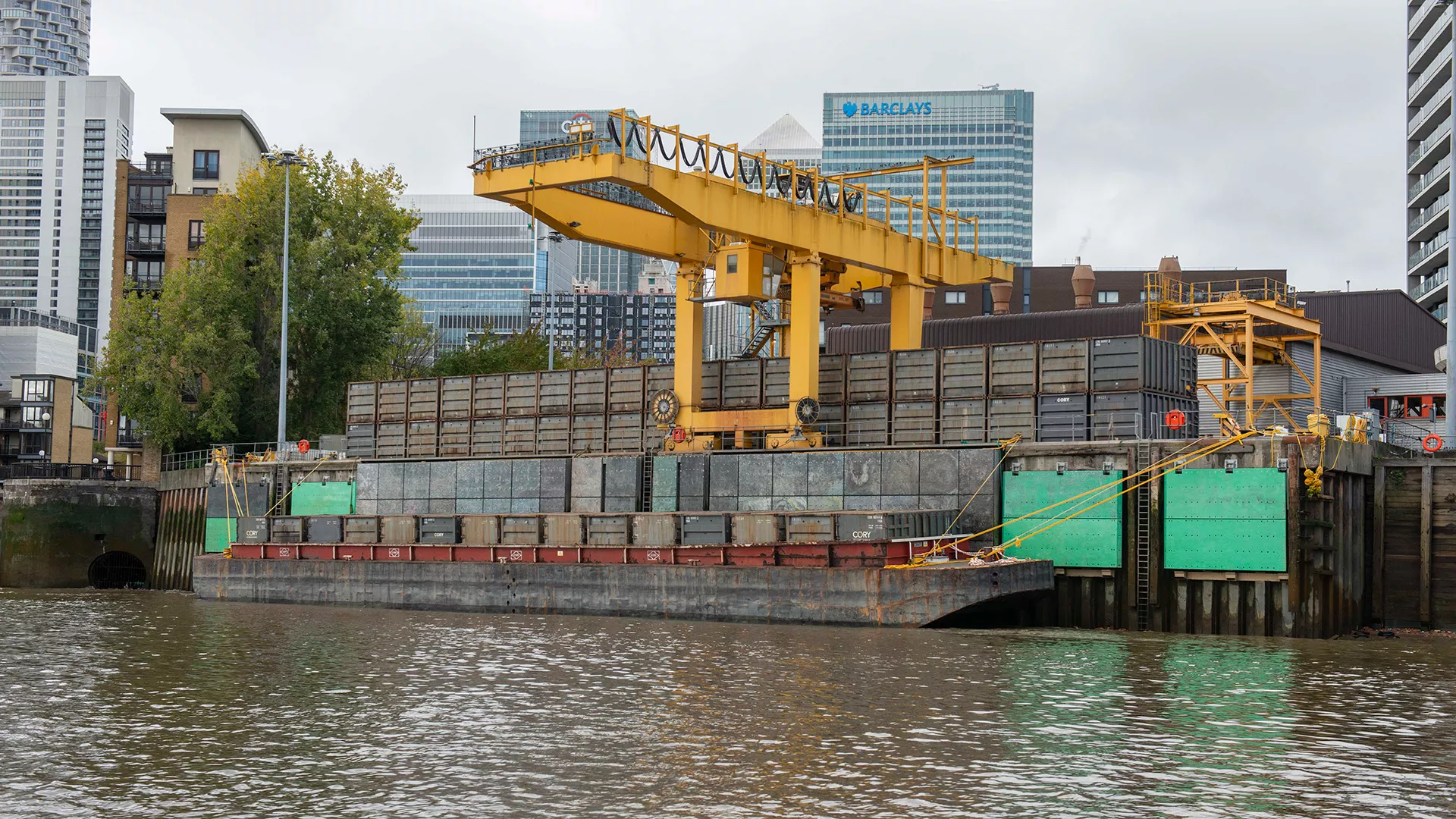
Help shape a plan to maximise the riverside's potential in Tower Hamlets and Newham.
Running until 15 February 2024, the consultation is the second in a series that will cover all 22 local authorities bordering the tidal Thames, from west London out to the estuary. Where possible, it coincides with the local councils’ Local Plan reviews.
Mike Atkins, Senior Planner at the PLA, explained:
“This is a chance for local people in Tower Hamlets and Newham to have their say on guiding investment decisions related to the river on their doorstep. It has been drafted in partnership with both local authorities serving the area, the Greater London Authority, the Environment Agency, landowners and river-based businesses. Now we very much want to hear what people living in the area think needs to be included.”
The development of the full Tidal Thames Masterplan, which started in 2023 with the outer London Borough of Bexley, supports the PLA’s Thames Vision 2050, working to grow trade on the river, improve its environmental value and attracting more people to use it for sport and leisure.
A key focus for the Masterplan is highlighting opportunities for investment arising from the upcoming introduction, through The Environment Act, of Biodiversity Net Gain requirements for developers to help wildlife when delivering projects.
Step 1: Explore Tower Hamlets and London Borough of Newham draft plans via our GIS Mapping tool.
Step 2: Send your feedback via the form on the site or to [email protected]
Pilotage, conservancy on vessels and cargo charges 2024
Use this calculator to estimate pilotage, conservancy on vessels and cargo charges.
Port of London Authority Charges Terms and Conditions 2024
These Regulations determine the basis upon which the Port of London Authority’s facilities and moorings may be used
This publication also sets out the circumstances under which payments are due to the PLA and establishes liability for those payments.
Port Information Guide
From anchoring to water safety: PLA services and navigation guidance
This guide has been produced for all river users, vessel owners and operators, publishers of nautical information and any other party that needs nautical information.
The Port of London Authority (PLA) makes every effort to make and maintain the contents of this document as up-to-date, accessible, error-free and complete as possible; however, the correctness and completeness of these contents cannot be guaranteed. The PLA accepts no liability for the occurrences and/or consequences of errors, faults or incompleteness, or any other omission in connection with the information provided by this document. In case of any discrepancies or inconsistencies between this document and the applicable legislation, including port regulations, the latter will prevail. Any substantive change to port regulations, practices or procedures would be reflected in amendments to this guide as soon as possible.
The Port of London Authority cannot guarantee the security of any external links used in this document. Any external links used will be marked with an asterisk (*).
The Port of London Authority (PLA) was established in 1909 as per the Port of London Act of 1968
(as amended) which is available our website: pla.co.uk/port-london-act
For Rules, guidelines and best practice for navigation on the Tidal Thames, visit our website: pla.co.uk/regulations-guidance
For queries about this guide, please contact our Harbour Master team: [email protected]
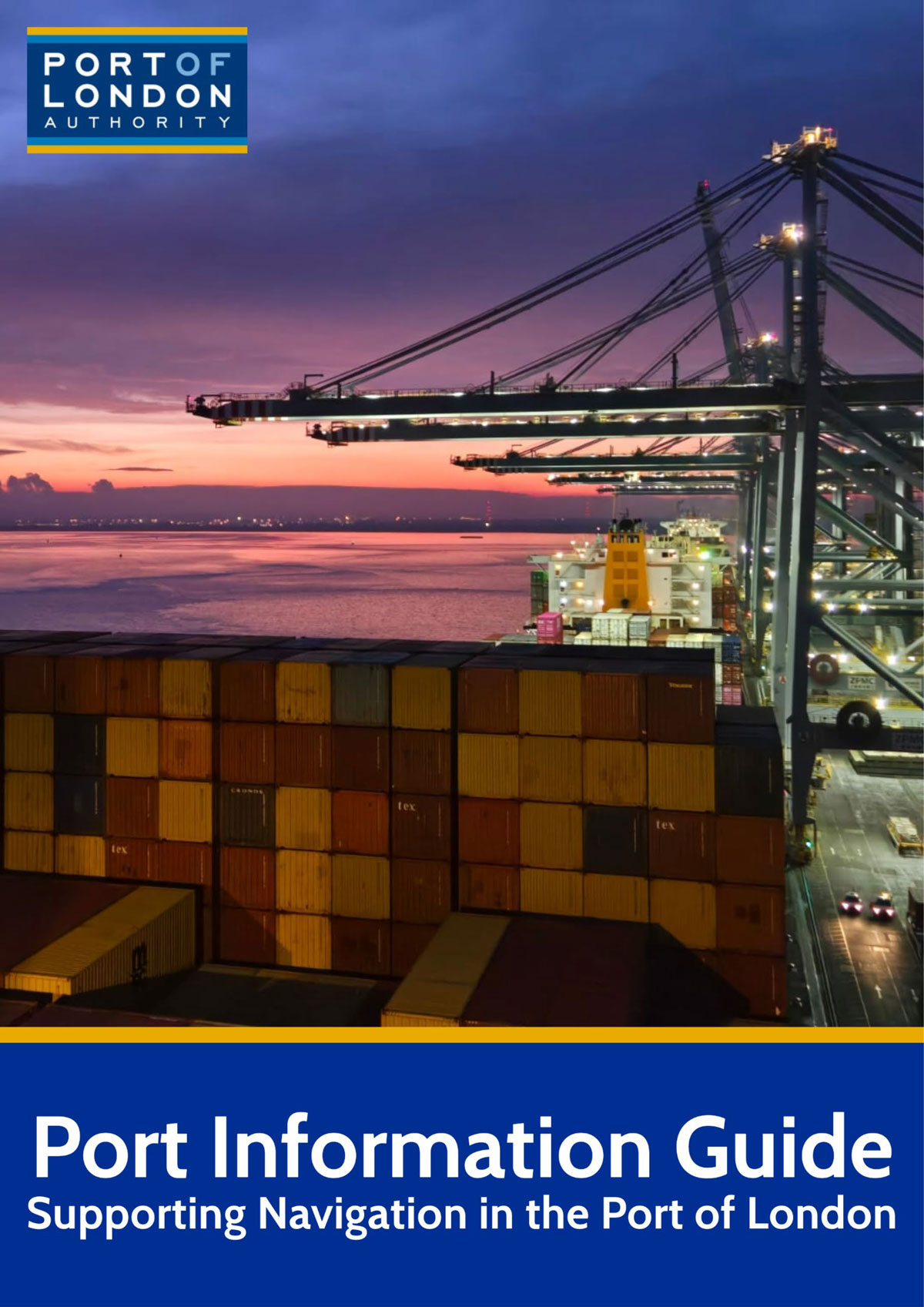
Cover photograph: Lee Marriott – PLA Pilot
Contact Us
For General Enquiries, contact the Port of London Authority using the details below:
London River House
Royal Pier Road
Gravesend
Kent
DA12 2BG
United Kingdom
General Enquiries: (+44) (0)1474 562200
For Safety of Navigation, Incident/Near Miss Reporting, Emergencies and issues requiring Urgent attention, contact London VTS. For more information see section ‘London VTS’.
Found an error in the information provided in this guide? Email us: [email protected]

Navigate to a section of the Port Information Guide
M - Marine Engineers, Marine Services, Marine Surveyors, Media Enquiries, Moorings
N - NAABSA Berths, NABSO, Navigation Warnings, Non-Tidal Thames, Notices to Mariners
S - Safety, Sewage Discharge, Ship Agents, Ship Towage Operations, Speed Limits, Speed Reductions
V - Vessel Immobilisation, Vessel Licensing, VHF Carriage Requirements
W - Wash and Draw-off, Waste Disposal, Water Safety, Weighted Heaving Lines, Works Overside
Latest changes (05 September 2025)
- Updated section on Bridges to include instructions for Persons in the Rigging.
- Updated section on Bunkering Operations introducing a new Bunkering Notification Form and restrictions at Tower Bridge Upper (HMS Belfast).
- Updated link to Marine Guidelines and Port Information in Port of Tilbury section.
- New section on Tower Bridge Upper (HMS Belfast) detailing restrictions on the provision of support vessels at this location.
- Updated section on Ship Towage Operations to include reference to the new Technical Requirements which came into force on 1 September.
A
ANCHORING
1. There are various designated anchorages in the Port of London, for a full list of anchorages, refer to the PLA Tide Tables and Port Information, available at: pla.co.uk/tidal-information#tables
2. For rules on anchoring in the Port of London, refer to our General Directions for Navigation in the Port of London (GD22): pla.co.uk/general-directions-navigation-port-london
B
BALLAST OPERATIONS
- The PLA does not have any specific restrictions on ballast water operations in the Port of London. Questions regarding ballast water operations should be directed to the Maritime & Coastguard Agency (MCA) via the vessel’s agents.
- Any vessels wishing to undertake ballast operations should adhere to UK and International Regulations, plus any restrictions/requirements of the berth owner/operator.
BERTHS
- For a list of commercial berths and terminals on the Tidal Thames visit: pla.co.uk/berths-terminals
- See also section NAABSA BERTHS.
BRIDGES
1. For a full list of clearance heights for bridges crossing the river and the various creeks along the Tidal Thames visit: pla.co.uk/thames-bridge-heights
(1.1) The clearance height of the main navigational arch for each bridge is referenced to the local Mean High Water Springs (MHWS) tidal level and is also included in the Chart notes and by the bridge location on PLA published charts. See below example extracts (Figure 1 and 2) taken from PLA Chart 316:
 Figure 1: Extract from PLA Chart 316 showing notes of bridge clearance heights at main navigational span
Figure 1: Extract from PLA Chart 316 showing notes of bridge clearance heights at main navigational span
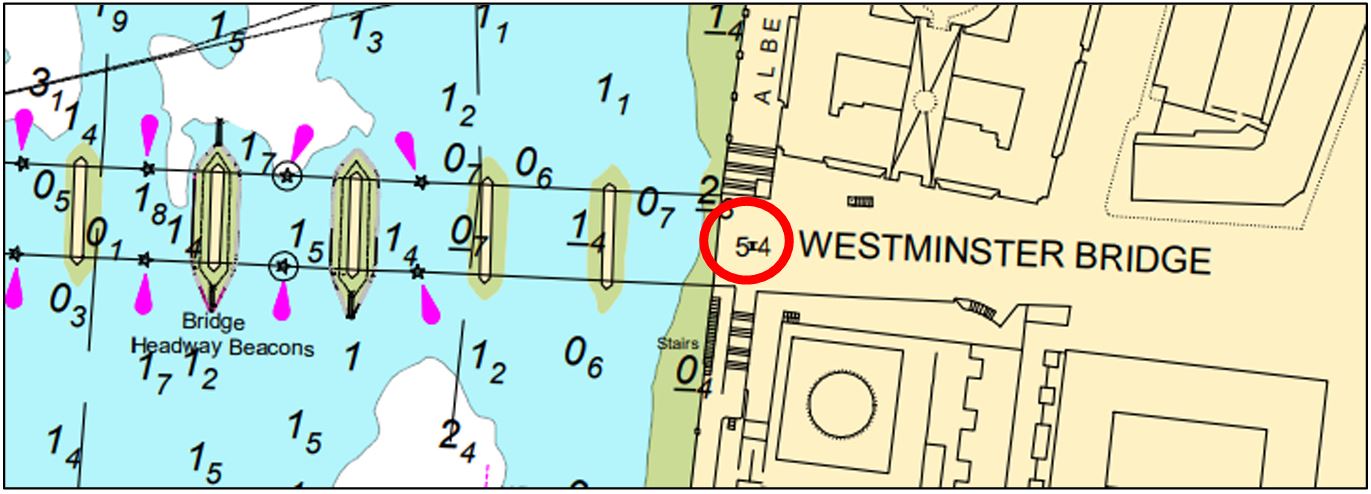
Figure 2: Extract from PLA Chart 316 showing bridge clearance height at main navigational span of Westminster Bridge
2. ARCHES CLOSED TO NAVIGATION
Arches on Thames bridges may be closed for various reasons from time to time. As per the PLA General Directions (General Direction 17.1 (e)), No vessel is to transit through a bridge arch which is closed to Navigation. Arches closed to navigation will be marked in accordance with the Thames Byelaws 2012:

- by day, three red discs 0.6 metres in diameter at the points of an equilateral triangle with the apex downwards and the base horizontal;
- by night, three red lights in similar positions to the discs displayed by day.
3. Arches closed/open/open to specific vessels may also be marked by the use of smart signals, as detailed below:
4. SIGNAGE AND LIGHTING ON ARCHES DURING MAINTENANCE OR CONSTRUCTION WORKS
During maintenance and construction works other appropriate signage and lighting as agreed by the Harbour Master may be displayed on or around bridge arches. The characteristics of these will be communicated in a Notice to Mariners as appropriate.
5. BRIDGE TRANSITS WITH SPECIAL PROCEDURES
As per the PLA General Directions (General Direction 28), vessels wishing to transit the following bridges must follow the procedures as described below:
5.1 Tower Bridge
Vessels with an air draft of 9 metres or more wishing to transit Tower Bridge may request a bridge lift at least 24 hours in advance, as described on the Tower Bridge website. Vessels intending to transit Tower Bridge which have arranged for the bascules of the bridge to be raised must:
- at Crayfordness inward-bound, or when departing a berth west of Crayfordness, notify London VTS of:
- a confirmed ETA for Tower Bridge; and
- the place at which the Vessel can safely abort;
- establish communications with Tower Bridge control 30 minutes before their ETA for Tower Bridge;
- not transit beyond their declared abort point until confirmation has been received from Tower Bridge Control that the bridge bascules will be raised in good time.
5.2 Deptford Creek Bridges
The bridges are able to open to river traffic 24 hours a day, every day of the year, but operation is based upon an advance notice system as the bridges are not staffed continuously. Vessels wishing to transit the Deptford Creek bridges must contact the bridges Controller on (+44) (0) 208 291 4561 at least 12 hours in advance, and by midday on a Friday or any other workday immediately preceding a public holiday for any opening required over a weekend or during a public holiday period.
5.3 Bow Creek – Leamouth/Canning Town footbridge
Vessels with an air draft of greater than 4.9m will advise London VTS on VHF Channel 14 or by telephone: (+44) (0) 203 260 7711 of a requirement for the bridge to be raised, giving an estimated time of arrival (ETA) at the bridge with a minimum notice period of 60 minutes whereby it will be ensured that no alarms are activated regarding operation of the bridge. If there are any issues likely to impact on the bridge operation these are to be informed to London VTS at this stage and confirmed as resolved at the 15 min confirmation communication exchange. 15 minutes before arrival at the bridge the vessel will confirm its ETA to London VTS.
5.4 Hammersmith Bridge
As part of the ongoing stabilisation and repair works at Hammersmith bridge, control lights have been installed either side of the bridge. The bridge control lights will display one of two signals: a green arrow or a red cross. (see 2.1 under the Bridges section for the meaning of these signals).
5.4.1 In the event of a bridge closure, an exclusion zone of 15 metres upriver and downriver of the bridge will be implemented. Mariners are advised that there is no set time duration of a closure as engineers investigate the cause of the alarm. All mariners are advised to have an abort and contingency plan available for a closure which may last longer than the tidal window available.
5.5 PERSONS IN THE RIGGING
To ensure the safety of all crew members and personnel aboard vessels transiting under bridges or entering docks within the Port of London, no individual shall be permitted in the rigging or elevated mast structures when transiting through bridge arches, immediately adjacent to a bridge, entering/departing a lock, or during any other sensitive operation as deemed necessary by the Harbour Master. This does not relieve the Master of their obligation to ensure that, at all times, rigging activities are fully risk assessed and carried out safely. This policy applies to all commercial, military, and private vessels.
BUNKERING OPERATIONS
(1) As per the PLA General Directions (GD9), a Bunker Vessel, or any Vessel receiving bunkers pumped from a shoreside facility or road tanker, must notify London VTS of the type of bunkers being transferred, and report to London VTS immediately before, and on completion of, Bunkering. Masters of vessels are reminded that bunkering operations within the Port of London are also subject to the following conditions:
(1.1) NOTIFICATION AND REPORTING
The Master of a vessel intending to deliver bunkers, shall give notification in writing by completing the following Bunkering Notification Form not less than 1 hour in advance of the intention to commence bunkering operations.
(1.1.1) Additionally, Vessels must report to London VTS before commencement of bunkering operations and give positive confirmation that their bunker checklists have been completed. Vessels must not commence bunkering operations without the permission of London VTS. Vessels must report to London VTS on completion of bunkering.
(1.2) CHECKLISTS
The Masters of any vessel intending to receive bunkers, shall complete a bunker checklist in conjunction with the supplying party, with all questions answered accurately.
(1.3) BUNKER VESSELS
Vessels which are both Intra-port Vessels and Bunker Vessels must notify London VTS of the type and amount of bunker cargo they are carrying aboard prior to every instance of getting Underway.
(1.4) REPORTING OF OIL SPILLS
The master of any Vessel involved in an oil spill must immediately report to London VTS. Information to be reported includes reporting location, type of oil, approximate quantity, and action taken to limit and control the spill.
(1.5) BUNKERING OPERATIONS AT ANCHORAGES INCLUDING TONGUE ANCHORAGE
Bunkering at Anchorages, including those outside Port Limits but within the London VTS Area (Tongue Anchorage), may only be conducted by vessels/companies which have been approved by the Harbour Master. Other organisations wishing to carry out bunkering operations outside of port limits but within the VTS Area should contact the Harbour Master ([email protected]). Bunkering in the Margate Road anchorage is not permitted.
(1.5.1) All vessels intending to enter the London VTS area, which are to be involved in ship-to-ship bunkering operations, shall provide standard pre-arrival and departure notifications via the PISCES system. Vessels carrying dangerous or polluting goods are required to declare them in advance of their arrival and departure.
(1.6) BUNKERING RESTRICTIONS AT TOWER BRIDGE UPPER (HMS BELFAST)
Bunkering operations (light fuels only) may only take place overnight, between 22:00 and 07:00. Heavy Fuel Oil bunkering is prohibited at any time at this location.
(1.7) ADDITIONAL REQUIREMENTS
Bunkering operations must not commence or must be suspended if the local weather conditions exceed Beaufort Force 6, sea/swell heights in excess of 2 metres, and constant winds exceeding 27 knots. However, London VTS or the Master of the bunkering vessel may direct, that bunkering operations be suspended in less adverse conditions if deemed necessary. All vessels anchored for the purpose of bunkering are required to have their main engines available at immediate notice. In addition, they are required to exhibit code flag ‘Bravo’ by day and an all-round red light by night. Whilst bunkering operations are in progress a 100m domain intrusion zone will be established around the vessel, which will be monitored by London VTS and by the vessel taking bunkers.
(2) List of bunker suppliers operating in the Port of London
C
CARGO OPERATIONS
1. A full list of Cargo Handlers operating within the Port of London is available here.
CERTIFICATE OF COMPLIANCE
1. Vessels wishing to exceed the speed limits defined in Thames Byelaw 16, a certificate of compliance issued by the Harbour Master is required.
2. A certificate of compliance will only be issued when a vessel operator can demonstrate compliance with the relevant provisions of the High Speed Craft Code and the Small Commercial Vessel Code together with the International Safety Management Code, and the carriage and use of AIS.
3. Further details of the requirements to be met for the issue of a certificate of compliance can be obtained from the Harbour Master by emailing [email protected]
4. If, as a result of compliance with a mandatory speed limit, a planing vessel produces unacceptable wash at 12 knots, the master should reduce speed further to ensure that the vessel produces safe levels of wash.
5. A certificate of compliance for the purposes of this byelaw is not to be taken as compliance for the purposes of any other requirement in PLA byelaws, general directions or provisions in the Act.
6. See also sections SPEED LIMITS and WASH AND DRAW-OFF.
CHARTS AND PUBLICATIONS
1. The Tidal Thames is covered across various publications including Admiralty Sailing Directions and Admiralty Charts, as well as our own Charts developed by our Hydrographic department. Visit pla.co.uk/hydrography to view our Hydrographic information. Our Hydrographic products are available for purchase from the PLA Shop.
2. To acquire Admiralty Charts and other Publications covering the Thames produced by the United Kingdom Hydrographic Office, visit: https://www.admiralty.co.uk/
3. Mariners should ensure Nautical Publications are always kept up-to-date, as well as ensuring they always carry the latest and most appropriate scale chart for the area in which they are navigating. Access all Port of London Chart Correction Advices (CCAs) here and for Admiralty Notices to Mariners (NMs) click here.
4. For any queries, please contact [email protected] or call +44 (0)1474 562207
5. Charts are available to download in pdf format from our website without cost.
CIVIL ENGINEERING
1. A full list of Civil Engineering providers is available here.
COMBINED SEWER OUTFALLS (CSO)
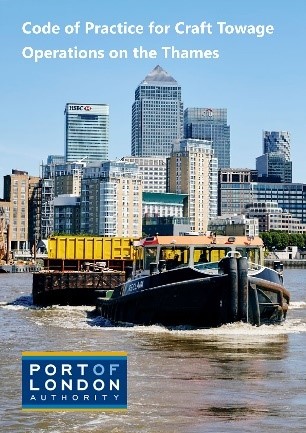 1. As part of the new Tideway Tunnel, some of the existing sewer outfalls have now been joined together into combined sewer outfalls (CSOs). The seven sites, located from the Lower Pool to Barn Elms Reach, are also now further into the river, closer to or in the navigation channel. All river users should familiarise themselves with the locations of these sites and the effects of a foul water discharge into the Thames. For more information read our Notice to Mariners (P6-24): pla.co.uk/notices/P6-24
1. As part of the new Tideway Tunnel, some of the existing sewer outfalls have now been joined together into combined sewer outfalls (CSOs). The seven sites, located from the Lower Pool to Barn Elms Reach, are also now further into the river, closer to or in the navigation channel. All river users should familiarise themselves with the locations of these sites and the effects of a foul water discharge into the Thames. For more information read our Notice to Mariners (P6-24): pla.co.uk/notices/P6-24
2. In the event of a discharge, flashing warning lights on each site will be activated, London VTS will issue a warning and include the CSO status on their routine navigational broadcasts on VHF 14. The current discharge status of each CSO can also be checked via our website: pla.co.uk/cso-status
3. The warning lights consist of two lights mounted vertically in front of a black backboard, flashing yellow with an alternating 1 second pattern, visible day and night with a range of up to 200 metres.
4. For more information, to assist with planning your passage past these sites and on the risks to navigation from each CSO discharges site, visit: *tideway.london/contact-us/document-library/cso-discharges-risk-to-navigation/
CRAFT TOWAGE OPERATIONS
1. The PLA has produced a Code of Practice for Craft Towage Operations on the Thames, provided for the guidance of Tug Masters, tug crews and those involved or associated with craft towage operations. It may also be of interest to other river users in providing an insight into the specialist work, and in some cases, the navigational limitations of tugs and tows.
2. The term ‘craft’ in this context applies to a wide range of both routine and non-routine tows, including dumb barges, jack-ups, dead-ship vessels and many more.
3. For more information visit: pla.co.uk/code-practice-craft-towage-operations-thames
4. For a full list of operators providing craft towage visit: pla.co.uk/port-business-directory#C
CRITICAL DEPTHS
1. Up to date information regarding critical depths along the tidal Thames is available here.
D
DANGEROUS SUBSTANCES IN BULK
1. For rules and regulations covering the transport of dangerous substances in bulk within the Port of London, visit our website: pla.co.uk/dangerous-substances-in-bulk-byelaws
2. See also section GENERAL DIRECTIONS FOR NAVIGATION.
DIVING
1. The Port of London Authority employs commercially qualified divers who are in demand for many different tasks. For more information visit: pla.co.uk/marine-services
2. Permission to Dive
Thames Byelaw 20 requires diving contractors to obtain permission from the Harbour Master prior to undertaking any diving activity in the Thames. To obtain permission, the diving supervisor is required to fill in and submit the diving permit to work form, together with copies of documents stated in the checklist. These documents shall be submitted to the Harbour Master: [email protected] with at least 2 working days’ notice. Further details are available on our website: pla.co.uk/commercial-diving
3. Depending on the location of the proposed diving operations, a Notice to Mariners and Speed Reduction may be required. See section NOTICES TO MARINERS and SPEED REDUCTIONS.
4. Vessels involved in Diving Operations
Thames Byelaw 33, in addition to the signals required by Rule 27(d) or (e) of the International Collision Regulations, requires a vessel supporting any diving activity permitted by the harbour master under byelaw 20 to:
a) by night, exhibit conspicuously an illuminated rigid replica of the International Code Flag “A’ not less than 1 metre in height; and
b) by day, exhibit conspicuously a red flag not less than 1 metre square in a position as close as possible to the diver’s point of entry into the water.
DRAUGHT CALCULATIONS
1. The water density of the Thames varies between berths and throughout the river. Density measurements also vary at different times of the day and year, and are significantly affected by local variations in salinity, temperature and by the weather.
2. Information regarding observed water density readings is available at: pla.co.uk/water-density-readings. These are provided to serve as a guide only for water densities that may be encountered on the Thames. The PLA accepts no responsibility as to their accuracy. It is recommended that for density values to be used for draught or freshwater allowance calculations, that in situ measurements are taken at the location of the vessel or terminal.
3. It is the Master’s responsibility to ensure they are aware of these variations and to submit their vessel’s actual deepest draught, taking into account water density.
4. Agents, berth and ship operators are reminded of the importance of supplying the correct vessel draught at the time of ordering a Pilot via PISCES. Accurate detail is critical and where this information is incorrectly provided, or frequently changes, there is an increased likelihood of a delay in the provision of a pilot.
5. In the event of any change in draught, agents, berth and ship operators are reminded to update PISCES with the correct information in reasonable time. Failure to do so may result in a delay to the vessel.
DREDGING
1. A dredging licence is required for any works involving dredging. Dredging is defined as including any operation to cleanse, scour, cut, deepen, widen, dredge or take up or remove material from the bed and banks of the Thames. Bed levelling, ploughing and hydrodynamic dredging fall within this definition.
2. Information on how to obtain a dredging licence is available here
3. A full list of Dredging Services offered within the Port of London is available here.
DRONES
1. The Port of London Authority has the responsibility to ensure safety to all of those using the Tidal Thames and as such need to be notified, at least 3 working days in advance, about any intended drone flight over the river. For more information about the use of Drones on the Tidal Thames visit: pla.co.uk/drone-operations
DRYING OUT FACILITIES
1. The PLA has two drying out facilities in the upper district; Strand-on-the-Green Grid and Isleworth Drawdock.
2. Isleworth Drawdock is a stretch of vertical river wall with regularly spaced piles and a riverbed suitable for taking the ground (for appropriate vessels), that is directly accessible by road. Isleworth is practically unlimited in the size of vessel it can accommodate.
3. Strand-on-the-Green grid is a timber grid suitable for smaller vessels, but without road access. The grid is limited to flat bottomed vessels of 25m length, 9m beam and a displacement of 200 tons. There is a tide board on the upriver pile of the grid, and it should be noted that there is no direct shore access at this facility.
4. More information including charges for using our Drying Out Facilities is available here.
E
EBB TIDE FLAG WARNING SYSTEM
1. Between Teddington and Putney, an Ebb Tide Flag Warning System is provided by the PLA to help indicate the speed of the fluvial flow to small boat users. It is similar to the red and yellow board system used by the Environment Agency above Teddington but on the Tideway it only applies to the ebb tide.
2. The flag status is updated every day at 6 am and 6 pm by taking the lowest tide reading for the Richmond tide gauge for the preceding 12 hours. The parameters for each flag colour are as follows:
- If the value is 2.6 metres or above, then the flag is RED.
- If the value is 1.7 metres or above but less than 2.6 metres, then the flag is YELLOW.
- If the value is 0 or above but less than 1.7 metres, then the flag is GREEN.
- If the value is less that 0 then the flag is BLACK.
3. To check the current status of the ebb tide flag warning system visit our website: pla.co.uk/ebb-tide-flag-warning
4. Prior to boating, rowers and paddlers are expected to have completed a risk assessment which ensures an adequate Passage Plan. The Ebb Tide Flag Warning System is a key element of any risk assessment and thus should be always monitored and adhered to. Those boating in contravention of the Ebb Tide Flag Warning advice would be in breach of the Tideway Code.
5. For more information on the meaning of the different flag colours refer to the Tideway Code: pla.co.uk/tideway-code
ECOLOGY
1. The Tidal Thames and Estuary is internationally recognised for its environmental importance for ecology. It is home to hundreds of thousands of over wintering and migratory birds,
115 different species of fish, 4 special protection areas and 9 sites of special scientific interest (SSSI). The Thames is important for marine mammals, including the harbour seal, grey seal and harbour porpoise. These species can be found throughout the estuary, including in Central London. Further information is available on ZSL’s State of the Thames report: *www.zsl.org/what-we-do/projects/state-of-the-thames-2021
2. For guidance on the local ecology of the Tidal Thames visit: pla.co.uk/poster-ecology-tidal-thames
3. For guidance on invasive species visit: *nonnativespecies.org/non-native-species/
4. For guidance on Marine Mammals on the Thames and how to report sightings, visit: pla.co.uk/get-involved
5. If you spot what you think is a stranded seal or another marine mammal on the banks of the Thames, please report it to the London VTS using the details in the Contact Us section.
EMERGENCY MOORINGS
1. Vessels requiring the use of an emergency mooring should contact London VTS using the relevant VHF channel or telephone number for the area they are in.
2. Vessels must not use moorings without permission from the Harbour Master (via London VTS) or the mooring owner.
EMERGENCY PREPAREDNESS
1. The Port of London Authority is a Category 2 responder under the Civil Contingencies Act 2004. In addition to supporting Category 1 responders, we will co-operate with other organisations in the planning, response and recovery for emergencies and support initiatives with implications for the tidal River Thames. More information about our Emergency Planning function is available here.
2. For routine Emergency Planning, Contingency Management and Resilience Issues, please contact the PLA by phone: +44 (0)1474562200 or email us at [email protected].
EMISSIONS REDUCTION
1. Air quality and emissions to air from vessels is a health and environmental priority in the UK and has been identified as being one of the top issues for ports in Europe. The operation of vessels on the Tidal Thames provides only a small percentage of the London atmospheric emission inventory, accounting for 1% of the capital’s emissions. However, the river’s overall contribution to London’s emissions is likely to increase as emissions from road vehicles fall due to tightening legislation, and use of the river grows. The Pla’s goal is to achieve Net Zero emissions on the river by 2040.
2. To read about our Air Quality Strategy for the Tidal Thames, visit our website: pla.co.uk/air-quality
3. To view our plan for supporting the decarbonisation of river-based emissions, visit:
pla.co.uk/net-zero-river-plan
ENVIRONMENT
1. The Port of London Authority is a harbour authority, a licensing authority and a landowner. This means we have certain commitments to provide environmental stewardship and champion environmental best practice. In our own Act we are required to maintain and improve the conservancy of the river and estuary.
2. Find out about our work looking after the environment of the tidal Thames, including habitat management, driftwood collection, Thames Barrier navigation and more by visiting https://www.pla.co.uk/Environment/. You can also contact our Environment team at [email protected] or by phone: (+44) (0)1474 562200.
EVENTS
1. The Thames is home to globally renowned events like the University Boat Race, traditional barge and cutter races and the Great River Race. To find out more about events on the river, visit: pla.co.uk/river-events to view our River Events calendar.
2. As per the Thames Byelaws (Byelaw 9), a person must not organise or promote a boat race, regatta, stunt, procession, exhibition, firework display, air race or other river event on or over the Thames except with the consent of the Harbour Master. For event organiser guidance visit: pla.co.uk/event-organiser-guide
EXCLUSION ZONES
1 As per the PLA General Directions (GD17), no vessel is to enter any Exclusion Zone shown on PLA charts or established in the Thames from time to time by the PLA. Vessels must also not approach within 60 metres of any Berthed tanker, or oil or gas jetty in the Thames. Vessels must not approach within 50 metres of any wind turbine tower unless for the purposes of construction or maintenance. Exclusion Zones in place on the Thames are described below:
1.1 Lambeth Reach
No person or vessel, shall, except in an emergency, or with the written permission of the Harbour Master, enter into an area within 70 metres of the northern bank of the river Thames between Westminster Bridge and 200 metres below Lambeth Bridge, as shown on charts, except as provided below. This restriction shall not apply to licensed passenger vessels approaching or departing from Westminster Pier. However, these vessels shall avoid entering into the area described, as far as safe navigation permits and at no time may they approach closer than 15 metres to the northern riverbank, as marked by yellow special marker buoys and shown on PLA charts.
1.2 Albert Embankment
An Exclusion Zone is established in the vicinity of Albert Embankment. The Zone extends from the upstream side of Vauxhall Bridge to the lower side of Lacks Dock extending from the embankment for a distance of 15 metres into the river. No vessel shall, except in an emergency or with the written permission of a Harbourmaster, navigate within or enter the Exclusion Zone.
1.3 Richmond Lock & Weir
Mariners should not enter the Richmond Lock, Weir and Footbridge Exclusion Zone whilst the weirs are in the lowered position or when they are being operated. Only when the weir gates are fully-raised, and the Closed Arch Signs have been removed is it permitted to navigate into the navigation exclusion zone and through Richmond Footbridge No. 2 or No. 3 arches. Only those vessels manoeuvring on or to the Lock island berths, vessels engaged in emergency operations or smaller vessels wishing to utilise the boat rollers in No. 1 arch are exempt from this requirement.
2 Additional Exclusion Zones may be implemented from time to time, and Mariners will be notified by a Notice to Mariners or by London VTS.
EXHAUST GAS SCRUBBERS
1. The PLA does not have any specific restrictions on the use of exhaust gas scrubbers in the Port of London. Masters of vessels fitted with these systems should consult UK national regulations. Questions regarding the use of scrubbers should be directed to the Maritime & Coastguard Agency (MCA) via their agents.
2. Individual berth operators may have their own restrictions on the use of scrubbers, agents/owners are therefore, advised to contact any berth operators directly for advice.
F
FILMING
1. All filming activity (and all commercial still photography) on the tidal Thames requires a filming licence. This includes ALL filming involving boats and vessels and filming on piers and other structures in the river. We can also advise on the possibilities for safe filming activity on the Thames foreshore (i.e. the part of the river exposed at low tide). Find more information on filming here.
FORESHORE PERMITS
1. Anyone searching the tidal Thames foreshore from Teddington to the Thames Barrier - in any way for any reason - must hold a current foreshore permit from the Port of London Authority. This includes all searching, metal detecting, ‘beachcombing’, scraping and digging. For more information about Thames Foreshore Permits including how to apply for a permit, visit: pla.co.uk/thames-foreshore-permits
G
GANGWAY ANGLE CALCULATOR
1. The PLA have produced a Gangway Angle Calculator to assist Masters of ships planning to use specified jetties, piers or berths with checking if their gangway / accommodation ladder arrangements are likely to comply or not with certain applicable regulations and guidance. For more information visit: pla.co.uk/gangway-angle-calculator
GENERAL DIRECTIONS FOR NAVIGATION
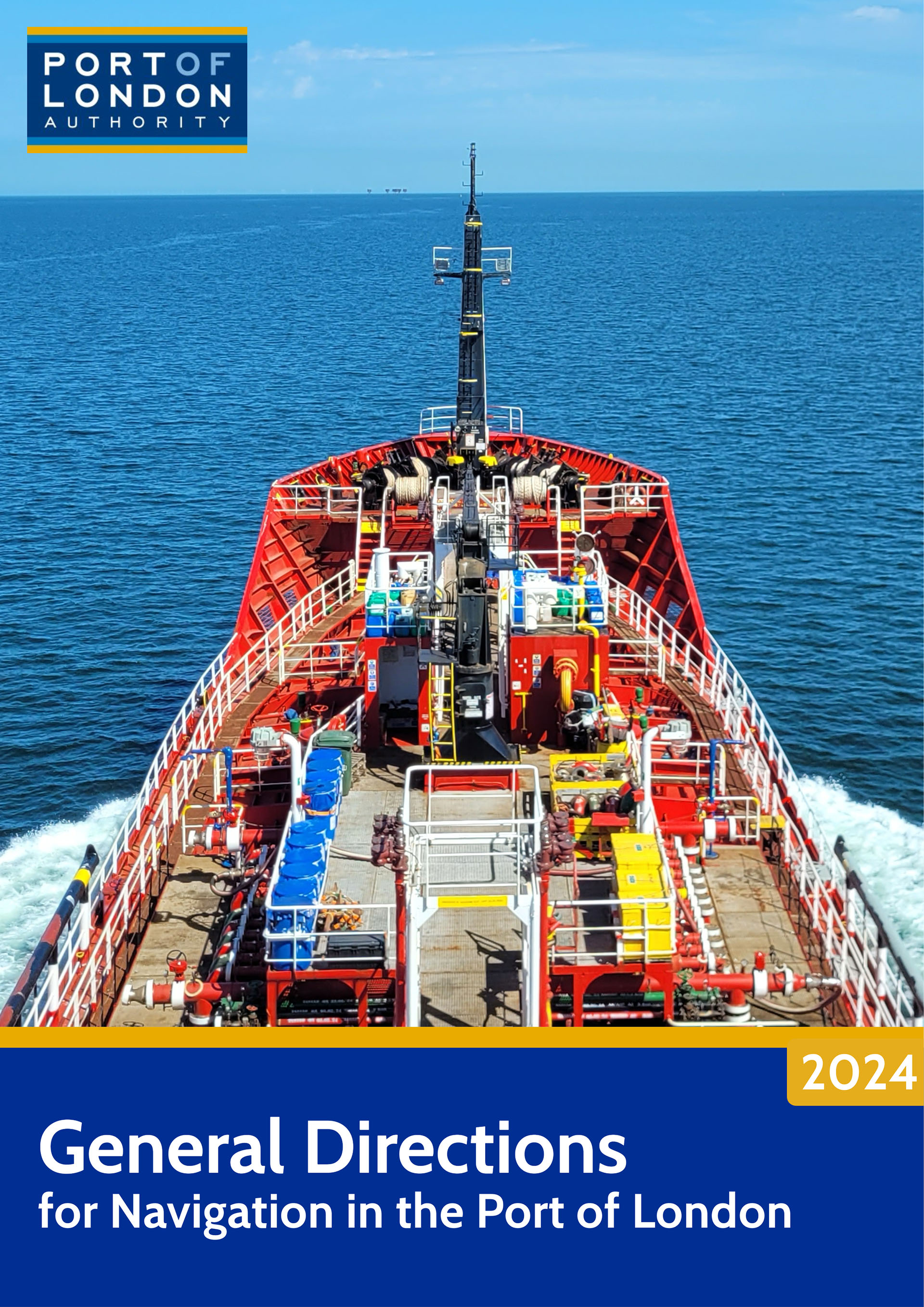 1. In order to maintain and enhance safety of Navigation on the Thames, it is important that Masters and watchkeepers are familiar with current Thames Byelaws, General Directions and Notices to Mariners. It is therefore vital that owners/agents ensure that all such publications and relevant information are promptly distributed to Vessels as appropriate.
1. In order to maintain and enhance safety of Navigation on the Thames, it is important that Masters and watchkeepers are familiar with current Thames Byelaws, General Directions and Notices to Mariners. It is therefore vital that owners/agents ensure that all such publications and relevant information are promptly distributed to Vessels as appropriate.
2. It is the duty of the Master of a Vessel to which a General Direction applies to comply with that General Direction. However, the giving of a General Direction does not diminish or in any other way affect, the responsibility of the Master in relation to his Vessel, Persons on board, its cargo or any other Person or property (Section 116 of the Act).
3. Failure by the Master of a Vessel to comply with a General Direction constitutes an offence, and renders that Person liable, on conviction, to a fine up to level 5 on the standard scale.
4. However, it is a defence for the Master of a Vessel to prove that he had reasonable grounds for supposing that compliance with the General Direction in question would be likely to imperil his Vessel or that in the circumstances, compliance was impracticable (Section 117 of the Act).
5. The PLA General Directions are available to download from our website: pla.co.uk/general-directions-navigation-port-london
GREEN TARIFF
1. Vessels visiting the Port of London that can show that they go beyond basic environmental requirements under the Environmental Ships Index (ESI) are eligible for a discount on port charges. The discount is automatically applied to eligible vessels.
2. For the details of the discount and eligibility, visit pla.co.uk/rates-charges.
H
HOUSEBOATS
1. Living afloat in a houseboat on the tidal Thames can be a great lifestyle, but requires careful consideration, especially for individuals new to the river. More information is available on our living afloat page.
HOT WORKS
1. Vessels wishing to undertake hot works (including burning, welding or other work involving naked flames) must seek permission from the berth operator and a notification to London VTS must be made prior to commencement and on completion of any hot works via the relevant VHF channel for the area, confirming that permission has been obtained from the berth operator.
2. Masters are advised to ensure the works are thoroughly risk assessed prior to commencement, with all due care and consideration given to the location, weather conditions, access and environmental impacts.
3. See also section on London VTS.
HYDROGRAPHY
1. The Port of London Authority (PLA) has the busiest port hydrographic department in the UK. The department also has dedicated survey craft fitted with multibeam echo sounder systems.
I
INLAND FLEET OPERATORS
1. Guidance for Inland Fleet Operators is available here.
INTRA-PORT VESSEL REGISTRATION
1. General Direction 32 details the requirement for all commercial intra-port vessels on the tidal Thames to be registered with the Port of London Authority (PLA), regardless of any other registration, licence or certificate held.
2. A dedicated portal is available to allow owners and operators to register their vessels: https://ipvr.pla.co.uk/home.
3. For more information, including a list of frequently asked questions visit this webpage.
L
LARGE VESSELS WEST OF MARGARETNESS
1. Large vessels intending to transit West of Margaretness point are required to follow specific procedures detailed in the General Directions for Navigation (GD28). Limits to vessel size are as follows:
1.1 Gallions Reach – London City Airport
Vessels with an air draught greater than 45 metres, intending to transit Gallions Reach in the vicinity of London City Airport.
1.2 Bugsby's Reach - London Cable Car
Vessels with a length overall greater than 130 metres and/or an air draught greater than 55.1 metres, intending to transit the London Cable Car in Bugsby's Reach.
(1.3) UPPER POOL
Vessels over 40 metres in Length Overall intending to proceed upriver to swing in the Upper Pool (between Wappingness and London Bridge) without calling at a berth or mid-stream mooring, must first gain Harbour Master approval. The agent or Master of the vessel must provide the Harbour Master by email ([email protected]) at least five working days before the swing:
• vessel name; and
• vessel LOA; and
• intended date of swing; and
• if swinging above Tower Bridge, the intended Tower Bridge lift/times; or
• If swinging below Tower Bridge, the intended swing location and time.
(1.3.1) The Harbourmaster will determine whether the operation can be facilitated and, where possible, grant approval. Such an operation shall not take place without harbourmaster approval. The harbourmasters decision is final.
2. For more information refer to the General Directions: pla.co.uk/general-directions-navigation-port-london.
LOCAL KNOWLEDGE ENDORSEMENT (LKE)
1. In July 2012 the PLA’s Thames Byelaws were implemented, which require the master of any commercial vessel between 40m and 13.7m length overall and those vessels under 13.7m length overall, which are engaged in passenger carriage or towing to hold a Local Knowledge Endorsement (LKE) for the Tidal Thames. This also applies to MCA Boatmaster Licence holders.
2. More information about Local Knowledge Endorsements (LKEs) is available here.
3. For further queries contact [email protected]
LOCAL TRAFFIC CONTROL
1. Local Traffic Control is typically conducted from a PLA Harbour Service Launch under the following circumstances:
a) Arrival and Departure of Large Vessels at certain locations such as Tower Bridge Upper and Greenwich Ship Tier
b) Major events and filming operations
c) Bridge Arch Closures
d) Emergency Situations
2. The implementation of Local Traffic Control will be announced on the VHF channel for the relevant sector and the Harbour Service Launch will display blue flashing lights for the duration.
3. Mariners intending to transit the area under Local Traffic Control are required to make contact with the attending Harbour Service Launch(es) on the VHF channel for the relevant sector and must follow any instructions given by the officers in attendance.
4. In the event of Local Traffic Control taking place whereby a Harbour Service Launch is unavailable, this may be carried out by London VTS, in which case this will be broadcast on the relevant VHF channel.
5. See also section RIVER CLOSURES.
LONDON GATEWAY PORT
1. DP World London Gateway Port is an independent Statutory Harbour Authority, sited within the boundaries of the PLA, is the UK’s most integrated logistics hub featuring a state-of-the-art deep-sea port and rail terminal on the same site as an expansive land bank for the flexible and fast development of logistics facilities and warehouses. Vessels arriving at London Gateway Port are advised that London Gateway Port have their own Vessel Information Guide which is available to download from their website .
LONDON VTS
1. Three Vessel Traffic Services (VTS) sectors are operated in the Port of London, each can be contacted as per the details below:
1.1 Estuary
- Main VHF Channel = 69
- Secondary VHF Channel = 18
- Telephone = +44(0)1474 560311
- Limits = Outer Limits to Sea Reach No. 4
1.2 River
- Main VHF Channel = 68
- Secondary VHF Channel = 20
- Telephone = +44(0)1474 560311
- Limits = Sea Reach No. 4 to Crayfordness
1.3 Barrier
- Main VHF Channel = 14
- Secondary VHF Channel = 22
- Telephone = +44(0)203 2607711
- Limits = Crayfordness to Teddington
2. Navigational Broadcasts including traffic information, cautionary areas, navigational and tidal information are issued every 30 minutes as per the below:
- Estuary - VHF Channel 69 - 15 and 45 minutes past every hour
- River - VHF Channel 68 - 00 and 30 minutes past every hour
- Barrier - VHF Channel 14 - 15 and 45 minutes past every hour
3. For more information about London VTS visit: pla.co.uk/vessel-traffic-services
4. See also sections LOCAL TRAFFIC CONTROL, REPORTING REQUIREMENTS, SPEED REDUCTIONS and VHF CARRIAGE REQUIREMENTS.
M
MARINE ENGINEERS
1. A full list of Marine Engineers operating within the Port of London is available here.
MARINE SERVICES
1. The PLA’s dedicated Marine Services team provides essential support to commercial and leisure users of the river. They ensure channels are clearly marked with lights and buoys, and provide a base for boat lifts and repairs. More information about Marine Services is available here.
MARINE SURVEYORS
1. A full list of Marine Surveyors operating within the Port of London is available here.
MEDIA ENQUIRIES
1. Members of the media may contact the team at this link.
MOORINGS
1. A full list of Visitor Moorings and Marinas on the Tidal Thames is available on our website pla.co.uk/visitormoorings. You must obtain permission from the berth or mooring owner/provider before using any facility. Due to the tidal nature of the river Thames, the majority of marinas have restricted access at certain times of day. You should contact marinas directly to confirm appropriate lock in times.
2. The PLA also own and manage some visitor moorings – to make enquiries, please call
+44 (0)1474 562421 or email [email protected]
3. There are various moorings for cruise ships and superyachts along the Tidal Thames as detailed below:
a) London Cruise Terminal (Tilbury)
b) Greenwich Ship Tier (Vessels up to 238m length)
c) George's Stairs Tier – downriver of Tower Bridge (Vessels up to 110m length)
d) Tower Bridge Upper – upriver of Tower Bridge (Vessels up to 158m length)
4. For further details on the PLA’s Central London Cruise Ship and Super Yacht Moorings including how to contact, visit: pla.co.uk/port-business-directory#C
5. For information regarding depths at ship tiers and moorings visit:
assets.pla.co.uk/hydrographic-services/navinfo/TIER_DEP.pdf
6. Booking enquiries for cruise ships and superyachts should be made via Capital Cruising’s website: * capitalcruising.co.uk/london/london-moorings/
N
NAABSA BERTHS
1. The Port of London Authority has published a procedure detailing the safe operation of NAABSA (Not Always Afloat But Safely Aground) Berths in the Port of London.
2. The safe operation of berths declared as NAABSA is the berth operator’s responsibility. The responsibility shall encompass that the vessel and the ground alongside the berth is safe and fit for purpose. The safe operation of the vessel is the responsibility of the vessel Master.
3. Any berths wishing to operate as NAABSA berths will need to declare compliance with the requirements detailed in the NAABSA procedure. To do so, berth operators should complete the NAABSA Berth Compliance Declaration form available on the website and submit to the Harbour Master for review.
4. The NAABSA Berth compliance declaration is valid for 12 months from the date indicated by the Harbour Master. The operator must submit a new declaration of compliance 30 days before the expiry date. Failure to renew the NAABSA status may result in delays and possible cancellations to vessel bookings.
5. A list of Approved NAABSA Berths in the Port of London as well as further information on NAABSA is available on our website: pla.co.uk/naabsa-berth-procedure-0
NABSO
1. Notices to Agents, Berth and Ship Operators (NABSO) provide essential, up to date information and advice to those supporting navigation and commercial shipping in the Port of London. Subjects will include (but not be limited to) advice on PLA procedures and/or requirements and notification of new and updated rules and regulations for navigation.
2. To view our current NABSOs visit: pla.co.uk/notices-mariners
3. See also section NOTICES TO MARINERS and NAVIGATION WARNINGS.
NAVIGATION WARNINGS
1. Navigation Warnings serve as a mechanism for the expeditious dissemination of essential, safety critical, navigational information to river and estuary users. The scope of such warnings encompasses various scenarios, including but not limited to:
- Displacement of navigational aids from their designated positions.
- Occurrence of severe or significant meteorological phenomena posing hazards to navigation.
- Malfunction or impairment of essential maritime equipment such as lights, fog signals, buoys, and navigational aids situated along primary shipping lanes.
- Presence of maritime obstructions such as wrecks, reefs, rocks, and shoals, which pose potential risks to major shipping routes.
- Emergence of drifting hazards, including derelict vessels or ice floes.
- Unforeseen alterations or closures of established navigational pathways.
- Anomalies affecting radio navigation systems, maritime safety information services delivered via radio or satellite, or related communication infrastructure.
- Identification of zones necessitating avoidance due to ongoing search and rescue operations or anti-pollution initiatives.
2. Navigation Warnings supplement the Notice to Mariners system by providing short term vital information. Navigation Warnings are time critical and will never last more than four days – where the danger exists, it will become a Notice to Mariners with greater detail provided. They are promulgated through these methods:
- Email Lists: addresses signed up for any type of Notice to Mariners.
- Email Direct: pre-defined key stakeholders
- Website: posted as a red banner at the top of the website
- Social Media: through the PLA’s various social media accounts
3. To ensure you receive Navigation Warnings, sign up to any of our Notice to Mariners email lists.
4. See also sections NOTICES TO AGENTS, BERTHS AND SHIP OPERATORS and NOTICES TO MARINERS.
NON-TIDAL THAMES
1. The Environment Agency is responsible for the navigation on the non-tidal river Thames upriver of Teddington Lock, for more information visit: *gov.uk/guidance/river-thames-locks-and-facilities-for-boaters
2. For information about inland waterways, visit the Canal & River Trust’s website: *canalrivertrust.org.uk/enjoy-the-waterways/canal-and-river-network
NOTICES TO MARINERS
1. Notices to Mariners provide essential, up to date information and advice to those supporting navigation and commercial shipping in the Port of London. Subjects will include (but not be limited to) advice on PLA procedures and/or requirements and notification of new and updated rules and regulations for navigation.
2. If you are carrying out works on the tidal River Thames, you may be required to have a Notice to Mariners issued. Contact our Harbour Master team at [email protected] to discuss if this is applicable to you.
3. View our current Notices to Mariners and subscribe to updates.
4. See also sections NABSO and NAVIGATION WARNINGS.
P
PASSENGER PIERS
1. For further information, visit Transport for London’s website.
PERSONAL WATERCRAFT (PWC)
1. The Thames Code for Personal Watercraft highlight all the important information relevant to the use of Personal Watercraft on the tidal Thames. Click here to download the code.
2. Remember: Do not use a PWC upriver of Lower Point Hope or enter restricted areas.
PILOT BOARDING AREAS
1. There are various Pilot Boarding Areas for the Port of London dependant on the size and draft of the vessel. A visual guide of the various Pilot Boarding Areas is available at here (This information is also available on charts and in the Admiralty Sailing Directions). For accurate details, include other operational information, visit: https://pla.co.uk/vessel-traffic-services
PILOTAGE
1. Pilotage is compulsory in the London Pilotage District as detailed in the table below:
2. PILOTAGE IN RESTRICTED VISIBILITY
During periods of Restricted Visibility, Pilotage is compulsory for all vessels between 50m LOA and 90m LOA with an Operating Draught ≥ 4m (≥ 5 metres East of Sea Reach No.1).
3. VESSELS EXCEPTED FROM COMPULSORY PILOTAGE
UK Warships and vessels in the long term service of HM Customs & Excise, Border Force and Trinity House in any part of the London Pilotage District. For more information visit: pla.co.uk/pilotage-directions-port-london
4. PILOT BOARDING AREAS
There are various Pilot Boarding Areas for the Port of London dependant on the size and draught of the vessel. A visual guide of the various Pilot Boarding Areas is available at: pla.co.uk/pilot-stations-boarding-and-landing-areas (This information is also available on charts and in the Admiralty Sailing Directions). For accurate details, include other operational information visit: pla.co.uk/vessel-traffic-services
5. PILOT SERVICE IN BAD WEATHER
The operation of Pilot Boarding Areas may be affected by weather conditions. To view the operational status of Pilot Boarding Areas for the Port of London visit: pisces.pla.co.uk/pilot-stations.html
5.1 The operational status of Pilot Boarding Areas is colour coded as follows:
- Green = On Station (Operating Normally)
- Amber = Pilot Station Restricted
- Red = Off Station (Not in Service)
5.2 For Larger/Deep Draught Vessels, if the Sunk Pilot Station goes ‘Off-Station’, there is the potential to utilise the NE Spit Station Via the Long Sand Head and DW Route, with relevant charges for the use of these routes being applied.
5.3 In times of adverse weather, and when normal pilot stations are Off Station, there are options should the master of the vessel wish to embark/disembark their pilot at Dover rather than wait, or over-carry them to the next port. Acceptance of these additional charges for pilot boarding outside their normal district must be confirmed by the agent and/or the Master.
5.4 In extreme weather circumstances where all stations are off and with Pilot Agreement, a Pilot may overcarry to a Continental port, following the provisions of Section 19 of the Pilotage Act 1987 and UKMPA legal advice. The agent must ensure they have advised the ships master and confirmed they can suitably accommodate the Pilot on board during the extended voyage. All arrangements to repatriate the pilot must be performed via the Agent.
5.5 The use of a Pilot joining at the Continental port during foreseen adverse weather conditions, with Pilot agreement is an option. Again, the Agent must ensure they have advised the ship's master and confirmed they can suitably accommodate the Pilot on board during the extended voyage, and all arrangements to transport the Pilot to the Continental port in question must be organised by the Agent.
5.6 All of the aforementioned options are technically outside of a PLA Pilots' Authorisation and are undertaken on a voluntary basis.
5.7 For further details refer to the Port of London Authority Charges, Pilotage Charges: pla.co.uk/rates-charges
6. Contact details for the various Pilot Stations are detailed below:
7. For further information about our Pilotage Service and details on how to order a Pilot visit: pla.co.uk/pilotage.
8. See also section PILOTAGE DIRECTIONS.
PILOTAGE DIRECTIONS
1. The Port of London Authority (PLA), as a Competent Harbour Authority within the meaning of the Pilotage Act 1987, and in the exercise of its powers under Section 7 of that Act, gives Pilotage Directions to the Masters of vessels in the London Pilotage District.
2. In order to maintain and enhance safety of navigation within the Thames, it is important that Masters and watchkeepers are aware of current Port of London Byelaws, Directions and Notices to Mariners. It is therefore vital that owners/agents ensure that all such relevant information and publications are promptly distributed to vessels.
3. It is the duty of the Master of a vessel to which a Pilotage Direction applies to comply with that Direction.
4. Failure by the Master of a vessel to comply with a Direction constitutes an offence, and renders that person liable, on conviction, to a fine up to level 5 on the standard scale. However, it is a defence for the Master of a vessel to prove that he had reasonable grounds for supposing that compliance with the Direction in question would be likely to imperil his vessel or that he had a reasonable excuse for his act or failure to act.
5. The Pilotage Directions for the Port of London are available to download from our website.
PILOTAGE EXEMPTION CERTIFICATES (PEC)
1. Information on how to apply for a Pilotage Exemption Certificate is available here.
PLA CHARGES
1. For a full list of the published rates and charges for services provided by the PLA, including Terms and Conditions for services provided visit: pla.co.uk/rates-charges
POLLUTION PREVENTION & RESPONSE
1. For guidance on pollution prevention, visit: pla.co.uk/pollution-prevention
2. In readiness for any pollution incident, the PLA-managed Thames Oil Spill Clearance Association (TOSCA) provides a 24-hour response to oil spills between Tower Bridge and Canvey Island. Response to pollution incidents upriver of Tower Bridge is managed by Marine Services and the Harbour Service. For more information visit: pla.co.uk/tosca
PORT BUSINESS DIRECTORY
1. The Port Business Directory includes links to all services, facilities and terminals available in the Port of London. For more information visit this webpage.
PORT LIMITS
1. The Port of London Authority’s Statutory Harbour Authority Area (SHA), spans the entirety of the Tidal river Thames, from the Teddington Obelisk on the Surrey bank just downriver from Teddington Lock, to the North Sea as pictured below.
2. This is described as in Schedule 1 of the Port of London Act 1968 (as amended) but in general terms includes the Tidal Thames from Teddington, encompassing both banks up to mean high water springs, eastward to Foulness Point in the north and Warden Point in the south. In the estuary the limits extend from Foulness point to Gunfleet Old Lighthouse, thence to a position 3 miles north of Margate, and back to Warden Point. The port limits exclude the river Medway, the Southend Foreshore and certain other creeks and rivers.
3. The London Pilotage District extends beyond the SHA limits as shown on our website: pla.co.uk/pilot-stations-boarding-and-landing-areas
4. The London VTS area extends beyond the SHA limits as shown on our website: pla.co.uk/vessel-traffic-services
PORT OF TILBURY
1. Forth Ports Port of Tilbury & Tilbury 2 is another major port on the river Thames. It is also the largest multi-modal port in the Southeast. Vessels arriving at the Port of Tilbury & Tilbury 2 are advised that Forth Ports have their own Marine Guidelines and Vessel information which is available to download from their website: *POTLL-PMSC-OP-09-07-Ports-of-Tilbury-and-Tilbury-2-Marine-Guidelines-and-Port-Information.pdf
2. The dimensions for the Lock at the entrance to the Port of Tilbury are detailed below:
- Length of Lock = 304.8 m (1,000 ft)
- Width at Impounded Level = 33.5 m (110 ft)
- Depth on outer sill below chart datum = 7.3 m (23.85 ft)
3. The period during which the Tilbury lock system can be operated is dependent on three factors:
- The height of water above the lock sills.
- The construction of the lock pierheads.
- Depth of water in lock approach.
4. The variation between Neap and Spring tides, together with abnormal tidal conditions caused by strong winds and also limitations imposed by siltation in the approach channels and lock entrances, do not permit any definite times relative to each H.W. to be laid down. For this reason, the following information can only be of a general nature and is intended to assist mariners approaching the Port of Tilbury to obtain some indication of the time they should arrive at Gravesend in order to dock on a particular tide.
5. Sill depths and lock dimensions are shown above. To find the level of water over the sill at any time, add the sill depth below chart datum to the height of the tide at the time required.
6. The height of tide can be estimated by using tables of predicted hourly heights. For our online Tide Prediction Tool visit: tidepredictions.pla.co.uk/
7. More precise information can be obtained from the Port of Tilbury by telephone (+44) (0)1375 852456 or via email [email protected]
R
RECREATIONAL USERS
2. We have a separate dedicated website for our partnership programme that supports the development of watersports on the Tidal Thames and inland waterways of London, Kent and Essex. For more information visit: activethames.co.uk/
3. We have produced a recreational user guide which can be downloaded from here. To order a large scale hard copy, printed on waterproof paper email us at [email protected] or [email protected]
4. A list of frequently asked questions regarding recreational river use is available here.
REPORTING ETA/ETD
1. Reporting vessels are required to report their movements to London VTS as indicated below:
1.1 INWARDS (All Ships)
- a) 24 hours before arrival; pass ETA and draught to Agents/Owners for onward transmission to the Port Control Centre (PCC) at Gravesend. Where ships from near ports cannot give the above notice, an ETA should be passed within one hour of departure from the last port of call. Notifications should be sent using the port’s on-line booking service (PISCES).
- b) In addition, Agents /Owners of vessels bound for the Port of Tilbury should contact the Marine Co-ordinator, telephone (01375) 852456.
- c) On passing the first Waypoint; pass all information not previously passed through agent and pertinent to the vessel’s arrival in the Port by VHF to PCC. Pass compliancy report in accordance with GD 13 and report security level.
- d) On passing each Waypoint; report by VHF to PCC for confirmation of onward clearance.
- e) On passing Sunk Head Tower Buoy or if using the Fisherman’s Gat, on passing the London Arrival/Departure arc or the North East Spit Buoy INWARD - declare an ETA for Knock John No 1 buoy. They are to report again when passing Black Deep No 5 Buoy, or if using the Fisherman’s Gat the Outer Fisherman’s Buoy giving an updated ETA for Knock John No 1 Buoy.
1.2 INWARDS (Ships requiring Pilots)
- a) A request for a pilot, including ETA at the pilot station should be passed to the PCC (Shipcon), with the 24 hours’ notice of arrival.
- b) A CONFIRMED order for a pilot must be given at least 8 hours before arrival at the Sunk Pilot Station or 6 hours before arrival at the NE Spit or Warp pilot station.
1.3 OUTWARDS or SHIFTING BERTH (All Ships)
- a) 24 hours before proposed movement in the river; pass ETD and draught to Agents/Owners for onward transmission to the PCC. Notifications should be sent using the port’s on-line booking service (PISCES).
- b) Immediately prior to commencement of movement in the river; pass all information pertinent to the vessel’s movement in the river by VHF to PCC and request permission to proceed.
- c) On passing each Waypoint; report by VHF to PCC for confirmation of onward clearance.
- d) On passing Sea Reach No 4 Buoy or, if departing the Medway ports, on passing the wreck of the Richard Montgomery, OUTWARD- declare the channels beyond Sea Reach No 1 buoy which they intend to use for navigation and, if planning to use the Princes Channel, make a specific declaration if planning to use the Princes Channel DW route.
- e) On passing Sea Reach No 1 buoy or the Medway buoy, and planning to use the Knock John Channel OUTWARD- report ETA for Knock John No 4 buoy.
1.4 OUTWARDS or SHIFTING BERTH (Ships requiring Pilots)
- a) A request for a pilot should be passed to the PCC with the 24 hours’ notice of departure is given.
- b) A CONFIRMED order for a pilot must be given to PCC at least 6 hours before departure or movement (unless the services of a River Pilot only is required as far as Gravesend or Sea Reach 1 when 4 hours’ notice is required.
2. Further information is also available in our website: pla.co.uk/vessel-traffic-services
3. See also section LONDON VTS and REPORTING POINTS.
REPORTING POINTS
1. Below is a diagram depicting all reporting points for the Port of London. These reporting points are also detailed on nautical charts and publications.
2. See also section REPORTING ETA/ETD and REPORTING VESSELS.
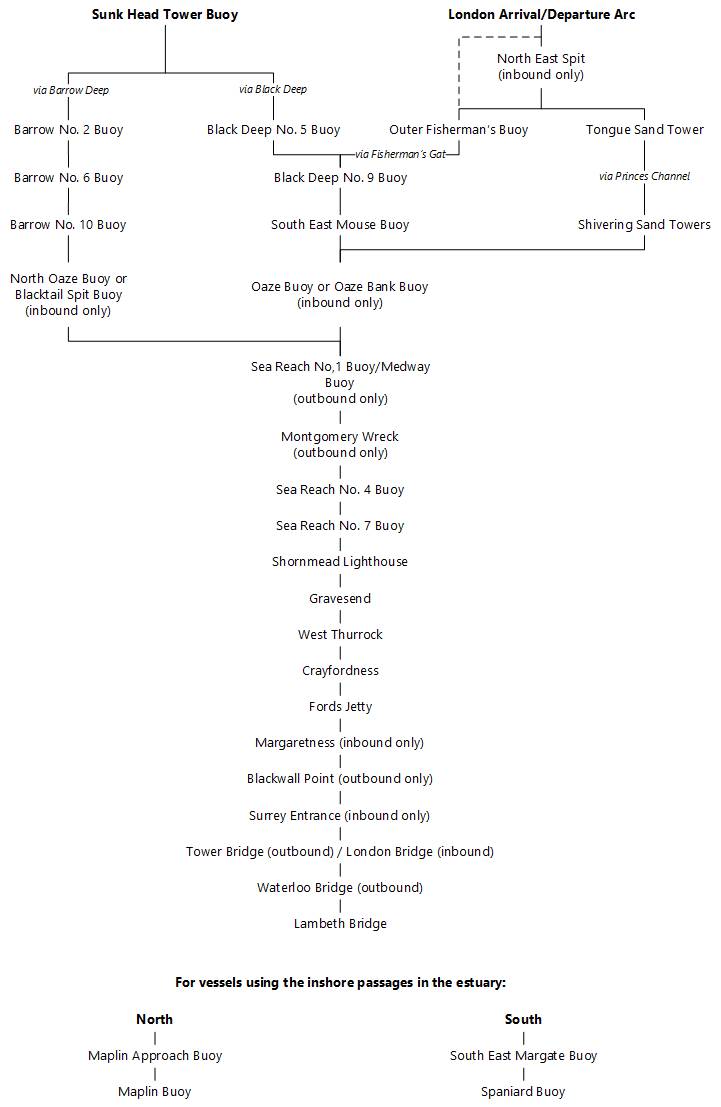
REPORTING VESSELS
1. Vessels of more than 40 metres in Length Overall, Commercial Vessels of gross tonnage of more than 50 tonnes which ordinarily also navigate outside the Thames; and tugs engaged in towing, or about to tow one or more vessels are required to report their movements to London VTS on the relevant VHF channel for the area. For full details of the requirements for reporting vessel movements in the Thames refer to our General Directions (GD7): pla.co.uk/general-directions-navigation-port-london
RICHMOND LOCK & WEIR
1. The Port of London Authority owns and operates Richmond Lock and Weir, which is also the base for the upper Thames harbour service patrols between Putney and Teddington Lock. For more information about Richmond Lock & Weir click here.
2. For current information please contact the Lock Foreman on 0208 940 0634.
3. See also section EXCLUSION ZONES, 1.3 Richmond Lock & Weir for information about exclusion zones in this area.
RIVER CRUISES
1. For a list of the various River Cruise operators and other passenger vessel operators, visit: pla.co.uk/port-business-directory#R
RIVER WORKS
1. Under Section 66 of the Port of London Act, a River Works Licence is required for any works in the River Thames, riverward of the mean high-water springs mark and regardless of ownership of the riverbed, including any works under the river or overhanging the river. This process ensures that all developments in the river are assessed for their potential effect on safety of navigation and the environment. For more information visit: pla.co.uk/licensing
2. For queries regarding River Works Licensing contact the Licensing team: [email protected]
S
SAFETY
1. Through the Port of London Act 1968 (as amended), the Port of London Authority has the primary responsibility of maintaining the safety of navigation and supporting the safety of vessels, the general public and all users of 95 miles of the Tidal Thames.
2. It should be noted that, vessel operators are required to have their own Safety Management System. Terminals, Berths and Marinas are required to comply with Port Marine Safety Code.
3. The PLA's management of navigational safety is in full compliance of standards set in the Port Marine Safety Code. Our Navigational Safety Policy is available at: pla.co.uk/navigational-safety-policy
4. For any Safety related queries, contact us via email at [email protected] or by phone (+44) (0)1474 562200.
SEWAGE DISCHARGE
1, Discharge of untreated sewage is prohibited. Vessels should adhere to UK and International regulations for the discharge of sewage, including the Thames Byelaws (Byelaw 49), and PLA General Directions (GD10). Vessels should also adhere to any restrictions/requirements of the berth owner/operator.
2. PLA Byelaw 49 came into force on 1 January 2015. The Byelaw prevents the discharge of sewage into the Thames from specified vessels, consistent with the continuing improvement of the Thames environment, particularly with Thames Water's project to stop the discharge of untreated sewage into the river, and brings the Thames into line with a number of other UK harbours and inland waterways. For further information visit: pla.co.uk/byelaw-49-prohibition-discharge-sewage-thames
SHIP AGENTS
1. A full list of ship agents and brokers operating on the Thames is available here.
2. For cruise ship agents, visit: pla.co.uk/port-business-directory#P
SHIP TOWAGE OPERATIONS
1. The PLA has produced a Code of Practice for Ship Towage Operations on the Thames, aimed to provide guidance for Masters, Pilots and tug crews involved or likely to be involved in ship towage operations on the tidal Thames. Ships’ agents are also recommended to make themselves familiar with the content of the Code, and in particular the application of Part Two - the Guidelines for the Utilisation of Ship Towage Tugs on the Thames. For more information visit: pla.co.uk/code-practice-ship-towage-operations-thames
2. All Ship Towage Tugs operating in the Port of London must undergo a safety and compliance inspection by the Harbour Master in order to be licensed for ship towage operations under the Port of London Vessel Licensing Byelaws 2014. From 1st September 2025, Ship Towage Tugs operating on the Thames are required to comply with the Technical Requirements for the Issue of a Ship Towage Licence available on our website: https://pla.co.uk/sites/default/files/2025-07/Technical-Requirements-Ship-Towage-Licence.pdf
3. A full list of all Ship Towage Tugs (including operational information) which are licensed to operate in the Port of London is available on our website: pla.co.uk/ship-towage-tugs
4. The towage operators contact details are available on our website: pla.co.uk/port-business-directory#T
SPEED LIMITS
1. Speed limits are imposed on various sections of the Tidal Thames and other areas as detailed below:

SPEED REDUCTIONS
1. When a reduction on vessel traffic speed is required, the term Speed Reduction or “Proceed at Slow Speed” is used by London VTS in appropriate broadcasts.
2. As a guide, requests for reduction in speed are appropriate for activities such as diving, salvage, heavy lifting, working on the waterline from scaffolding or pontoon/small boat, and bunkering operations. They may also be appropriate where the mooring facilities are limited e.g. when the vessel overhangs the berth or when a vessel is about to take the ground at a NAABSA (Not always Afloat but Safely Aground) berth.
3. A request for a reduction in speed of passing traffic should not be sought as an alternative to good seamanship such as the proper tending of lines and moorings in a tideway.
4. When London VTS has agreed to broadcast a reduction in speed:
- i) The activity requiring the speed reduction will be identified in the broadcast, from which Mariners should judge the speed appropriate to the circumstances.
- ii) The person responsible for the request must ensure that the vessel or installation concerned is displaying the international code flags “Romeo Yankee” by day and illuminated rigid replica by night. Failure to do so will result in the termination of the broadcast.
- iii) London VTS should be informed as soon as there is no longer the requirement for a speed reduction and the Romeo Yankee signal removed. The speed reduction broadcast by London VTS will also be terminated.
T
TERMINALS DIRECTORY
1. A list of terminals on the tidal Thames is available here.
THAMES AIS
1. Thames AIS is a key navigational safety tool to improve the situational awareness of vessels navigating on the river Thames and to provide additional safety critical information to London VTS.
2. The system was revised in 2023 after a consultation resulted in a new approach and subsequent revision of the Thames AIS Technical Requirements Specification which serves as an appendix to Thames Byelaw 12 – Thames AIS Carriage Requirements.
3. For full details on Thames AIS visit our website: https://pla.co.uk/vessel-traffic-services#ais
THAMES BARRIER CONTROL ZONE
1. The Thames Barrier is one of the largest movable flood barriers in the world. The Environment Agency runs and maintains the Thames Barrier as well as London’s other flood defences.
2. A permanent Control Zone, encompassing the Thames Barrier, is established between Margaretness and Blackwall Point. All vessels navigating within the Control Zone are subject to the requirements of the General Directions (GD17).
3. The Thames Barrier consists of nine piers numbered 1 to 9 from north to south and ten spans lettered A to K from south to north (see Figures 1 & 2 below):
- a) Spans B to G are open to navigation subject to the restrictions in the General Directions.
- b) Spans C, D, E and F are 61m wide with a depth of 5.8m below Chart Datum.
- c) Spans B and G are 31.5m wide with a depth of 1.2m below Chart Datum and have depth boards on Piers 3 and 9.
- d) Spans A, H, J and K are permanently closed to navigation.
4. Under normal circumstances, and subject to the requirements of partial closures, the northern spans E, F and G are used for inward-bound traffic and the southern spans B, C, and D are used for outward-bound traffic. Note: D span may be used by large inward bound vessels.
5. NAVIGATION LIGHT SIGNALS AND SHAPES
Each navigational span of the Thames Barrier has an array of traffic signals on the ends of the adjacent piers to indicate the spans open to navigation and those that are closed. The light signals will be displayed both by day and by night. Spans are open only to traffic in a single direction at any one time. The intensity of the light signals may be varied by the Thames Barrier Navigation Centre (London VTS) on request. The signals displayed depending on the navigational status are as follows:
5.1 SPANS OPEN TO NAVIGATION
Green Arrows will be exhibited from the ends of piers either side of the span(s) open to navigation. The arrows point inwards towards the span open to navigation from a particular direction.
5.1 SPANS CLOSED TO NAVIGATION
Red Crosses will be exhibited from the ends of the piers either side of span(s) closed to navigation from one or both directions.
5.3 SPANS PERMANENTLY CLOSED TO NAVIGATION
Span A to the south and spans H, J and K to the north are permanently closed to navigation and display at their centres the signals prescribed in the River Byelaws for closed bridge arches, namely:
- a) By day, three red discs 0.6m in diameter at the points of an equilateral triangle, with the apex downward and the base horizontal.
- b) By night, three red lights in similar positions to the discs displayed by day.
5.4 FOG LIGHTS
High intensity fixed white lights are situated at the ends of piers 4, 5, 6, 7 and 8 and are operated in conjunction with green arrows in reduced visibility. The lights may be switched on or off, or the intensity varied by the Thames Barrier Navigation Centre (London VTS) on request.
6. BARRIER CLOSURES
The Thames Barrier will be closed under the following circumstances:
- a) Emergency (Full) Closures - For flood prevention in the event of a surge tide warning and other emergencies. In normal circumstances, notice of a potential flood protection closure will be given approximately 12 hours before the predicted high water at the Thames Barrier.
- b) Test (Full) Closures - For the purpose of testing the Thames Barrier machinery and carrying out experiments to improve closure methods. Closures will be promulgated by Notice to Mariners published every six months. Such closures may occur at any state of the tide. Mariners, owners, and agents are advised to retain these Notices to Mariners, as no further notice will be given until 24 hours before the closure.
- c) Partial Closures - For maintenance, other works and training. On occasions it is necessary to close individual spans for maintenance or training. A single floodgate can be in the defence or maintenance position for a prolonged period of time. The span closed signals will be displayed, and vessels are prohibited from approaching these spans.
6.1 Note: When a gate is in the defence position next to a span open to navigation, mariners are advised that variations to the normal current direction and velocity may be experienced.
7 TRAFFIC CONTROL PROCEDURES DURING A FULL THAMES BARRIER CLOSURE
Vessels programmed to transit the Thames Barrier during a full closure will be subject to the following Traffic Control Procedures:
- a) Inward bound seagoing vessels proceeding to berths above the Thames Barrier will be instructed to anchor in a Designated Anchorage by London VTS.
- b) Outward bound seagoing vessels from berths upstream of the Thames Barrier will be directed to remain on the berth by London VTS possibly via the berth operator or agent.
- c) Non-seagoing vessels will be directed to appropriate moorings and berths.
- d) The approximate time of the Thames Barrier re-opening will normally be known at the same time as closure commences and will be passed to vessels directed to wait.
7.1 Note: If the flood prevention barriers situated at Tilbury Lock, Barking Creek, Dartford Creek, and Benfleet Creek are to be closed to navigation, traffic will be similarly directed as in a) to c). Individual instructions will be passed by London VTS as appropriate.
THAMES BYELAWS
1. The Port of London Authority in exercise of its powers under sections 162, 167 and 168 of the Port of London Act 1968 makes the Thames Byelaws, also known as the Port of London Thames Byelaws 2012. The byelaws relate to the management and regulation of marine operations and navigation in the Port of London.
2. Any person navigating on the Tidal Thames is required to follow these Byelaws. Failure to comply with these regulations is a criminal offence and may result in enforcement. To read the Thames Byelaws, visit our website: pla.co.uk/port-of-london-thames-byelaws.
THAMES GREEN SCHEME
1. The Thames Green Scheme is an independent environmental performance indicator for UK inland waterways commercial and services operators to demonstrate their environmental performance for elements including on air quality, carbon, energy, water quality, litter, and waste. Read more about the green scheme on our website: pla.co.uk/thames-green-scheme
THAMES VISION 2050
1. Launched in 2022, the Thames Vision 2050 is the development strategy for the tidal Thames running from Teddington Lock, through the heart of London out to the commercial port and estuary. The Vision is built around three interconnected themes, centred on the role the river plays for people and the environment. For more information about the project, visit: pla.co.uk/thames-vision-2050
TIDES & TIDAL INFORMATION
1. The Thames from the Teddington Lock to the North Sea is a tidal river. Our Hydrographic department have produced a collection of tidal information which is available on our website: pla.co.uk/tidal-information
2. Information on our website includes:
- a) Live tides
- b) Tide Prediction Tool
- c) Tide tables (readable and downloadable)
- d) Tide Differences
- e) Definitions and notes
3. For any queries, please contact PLA Hydrographic Service at: pla.co.uk/hydrography or call +44 (0)1474 562207
TIDEWAY CODE
1. Navigating any type of small recreational vessel on the tidal Thames, or Thames Tideway as it is also known, requires knowledge of the river and how it operates. The Tideway is by far the busiest inland waterway in the UK which, coupled with a fast-flowing tide and many bridges, piers and moorings, creates a challenging waterway on which to navigate.
2. The Tideway Code – aimed at both rowers and paddlers – has been produced by The Port of London Authority, Thames Regional Rowing Council and Paddle UK to advise both new and existing users who plan to navigate anywhere along the tidal Thames between Teddington Lock and the Sea. You can download a copy of The Tideway Code here.
TOWER BRIDGE UPPER (HMS BELFAST)
(1) The following restrictions apply on the provision of support vessels at Tower Bridge Upper:
a) Single vessel transfers (excluding bunkering) may take place at any time (e.g. waste and water).
b) Bunkering operations (light fuels only) may only take place overnight, between the hours of 22:00 and 07:00. Heavy fuel oil bunkering operations are prohibited at any time at this location.
c) Double banked operations (two vessels moored abreast) may also only take place overnight, between the hours of 22:00 and 07:00.
V
VESSEL IMMOBILISATION
1. It remains for the Master to decide it is safe to immobilise the vessel, taking account the berth or anchorage, and all parameters of wind and tide both existing and forecast for the period of immobilisation. The Master should adhere to any restrictions/instructions from the berth owner/operator.
2. Please inform London VTS 30 minutes prior to, and on completion of immobilisation, on the appropriate VHF channel so that an overview of the situation within port limits is maintained.
VESSEL LICENSING
1. The Port of London Authority, through powers granted to it by the Port of London Act 1968 (as amended) is responsible for the licensing of inland waterways vessels operating commercially on the tidal Thames. Vessels operating on the tidal Thames are required to be licensed by the PLA, unless they are certificated by another recognised authority, such as the Maritime & Coastguard Agency, another navigation authority or local authority.
2. Information about Vessel Licensing, including how to apply for a commercial vessel licence is available here. Read our Vessel Licensing Byelaws here.
3. For a list of Frequently Asked Questions about Vessel Licensing visit this page.
VHF CARRIAGE REQUIREMENTS
1. The following vessels must have an operational VHF radio readily available for communication with London VTS at all times when Underway or at anchor in the Thames:
a) Commercial Vessels of more than 7.0 metres in Length Overall; and
b) Pleasure Vessels of 13.7 metres or more in Length Overall, except:
- i. narrow boats more than 13.7 metres in Length Overall navigating between Brentford and Teddington; and
- ii. Vessels under oars.
(2) Other exceptions apply, for more details refer to the General Directions (GD12):
pla.co.uk/general-directions-navigation-port-london
W
WASH AND DRAW-OFF
1. As the master of a power-driven vessel on the River Thames, you bear a responsibility for the safety of passengers, crew, fellow river users, and the environment. The disturbance caused by your vessel moving through the water, known as "wash," and the interaction between vessels, known as "draw-off," can pose significant dangers.
2. Vessel Wash: Wash, essentially the waves produced by a vessel displacing water, varies in size and intensity based on vessel size, speed, hull shape, and water conditions.
3. Draw-Off (Vessel Interaction): Draw-off occurs as a result of a single vessel in motion passing moored vessels in close proximity, resulting in hydrodynamic forces that can pull nearby vessels from their moorings. There is an increased risk of draw-off where berths lie close to the channel edge.
4. Dangers Include:
- Risk to houseboat occupants, including falling items.
- Damage to smaller vessels, which may capsize.
- Hazards to swimmers and divers due to turbulence.
- Environmental harm from disturbed ecosystems.
- Disruptions in navigation and potential shoreline damage.
- Noise pollution affecting marine life.
- Erosion of coastal areas.
5. The Port of London Authority (PLA) receives numerous incident reports annually, with a substantial portion being wash complaints in specific areas. Legal consequences can include fines, and reporting offenses is encouraged to improve safety. Various factors influence vessel wash, emphasising the need for vigilance and compliance with regulations to ensure safety and protect the environment.
6. To report a Wash or Draw-off incident, visit our website: pla.co.uk/near-miss-and-safety-observations. Houseboat residents should submit wash or draw-off reports via the following online form with as much information as possible: pla.co.uk/houseboat-wash-reports
WASTE DISPOSAL
1. For information regarding Waste Disposal in the Tidal Thames area, visit: pla.co.uk/waste-management-plan
2. For a list of Waste Disposal providers, visit: pla.co.uk/port-business-directory#W
WATER SAFETY
1. We are committed to reducing the number of people who drown in the tidal Thames, either accidentally or through suicide.
2. As a founder member of the Tidal Thames Water Safety Forum (TTWSF), we work alongside HM Coastguard, RNLI, London Fire Brigade, Metropolitan Police (Marine Policing Unit) and London Ambulance Service.
3. Together we are working to make the river a safe place for all users, including dog walkers and joggers on the foreshore, who may become stranded due to the river’s fast moving tides, and people visiting riverside pubs and restaurants.
4. More information on Water Safety is available here.
WEIGHTED HEAVING LINES
1. Masters and crews of vessels visiting the Thames are required to use properly constructed heaving lines for all mooring and towing operations. The use of ‘weighted' heaving lines is both prohibited and extremely dangerous. These may cause serious injury or a fatality to those on the receiving end, either ashore or onboard a tug or mooring boat.
2. The MCA has issued a policy on reporting and management of inappropriately weighted heaving lines. The Port of London Authority reports all instances of dangerously weighted heaving lines to the MCA. This may result in enforcement action being taken against the vessel.
3. Masters of vessels and Agents are reminded that heaving lines with inappropriate weighting, such as pieces of metal, are not to be used under any circumstances. This dangerous practice is causing unacceptable risk to tug crews and shore mooring teams, and appropriate enforcement action will be taken as necessary.
4. Shore mooring teams and tug crews have instructions to cut off weighted “monkeys’ fists” or any other added weights from heaving lines, where used. The weighted “fist” or added weight will be retained as evidence in the event of proceedings being taken against the vessel and/or individuals involved.
5. The use of messenger rope is also strongly discouraged as this type of rope is significantly heavier than standard heaving line rope (<12mm diameter).
WORKS OVERSIDE
1. Vessels wishing to undertake maintenance works overside (including painting) are required to notify London VTS 30 minutes prior to works commencing, and again on completion of works once all persons are back onboard.
2. Works overside must be undertaken in daylight hours only and must be thoroughly risk assessed prior to commencement, with all due care and consideration given to the location, weather conditions, access and environmental impacts.
3. The Master must ensure that permission from the berth operator is in place. For maintenance at anchorage, permission from the Harbour Master must be obtained.
Discover
